NetComm Wireless NHD1W ACCESS POINT User Manual
NetComm Wireless Limited ACCESS POINT
User Manual
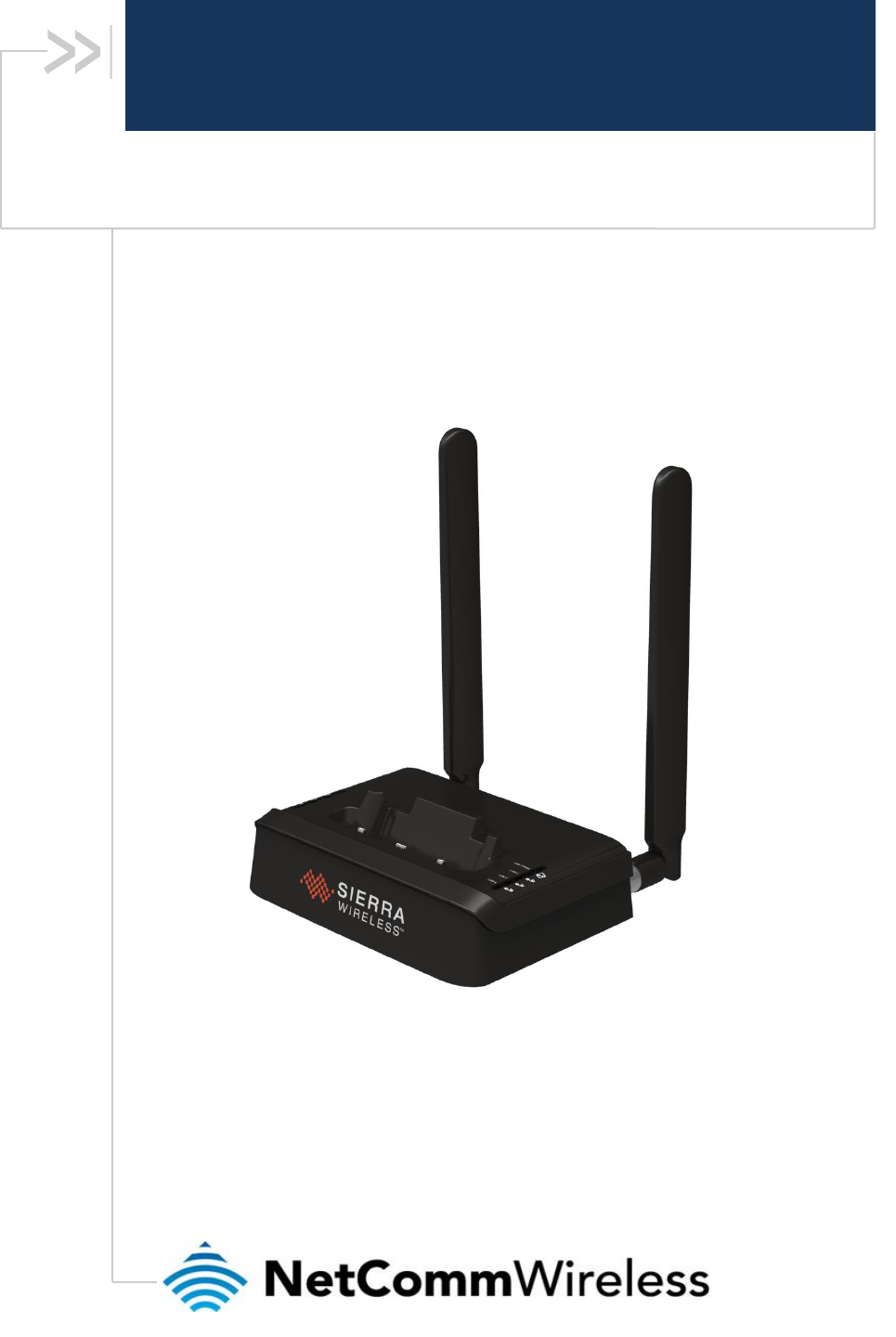
User Guide
NetComm Hotspot Dock (NHD1W)
2400164
Rev 1

2 2400164
NHD1W User Guide

Preface
Rev 1 Feb. 2012 3
Important Notice
Due to the nature of wireless communications, transmission and reception of data can never be
guaranteed. Data may be delayed, corrupted (i.e., have errors) or be totally lost. Although significant
delays or losses of data are rare when wireless devices such as the NetComm Wireless NHD1W are
used in a normal manner with a well-constructed network, the NetComm Wireless NHD1W should not
be used in situations where failure to transmit or receive data could result in damage of any kind to
the user or any other party, including but not limited to personal injury, death, or loss of property.
NetComm Wireless accepts no responsibility for damages of any kind resulting from delays or errors
in data transmitted or received using the NetComm Wireless NHD1W, or for failure of the NetComm
Wireless NHD1W to transmit or receive such data.
Safety and Product Care of NHD1W
With reference to unpacking, installation, use and maintenance of your electronic device, the following
basic guidelines are recommended:
Do not use or install this product near water to avoid fire or shock hazard. For example, do
not use or install this product near a bathtub, kitchen sink, laundry tub, or near a swimming
pool. Also, do not expose the equipment to rain or damp areas (for example a wet
basement).
Do not connect the power supply cord on elevated surfaces. Allow it to lie freely. There
should be no obstructions in its path and no heavy items should be placed on the cord. In
addition, do not walk on, step on or mistreat the cord.
Warning : Disconnect the power line from the device before servicing.
To safeguard the equipment against overheating, make sure that all openings in the unit
that offer exposure to air are unobstructed.
Safety and Hazards of AirCard Mobile
Hotspot
The AirCard mobile hotspot MUST BE POWERED OFF in all areas that may be susceptible to radio
interference, in particular:
Prohibited areas
Obey all signs and notices and follow all rules and regulations. Power off the mobile hotspot
when instructed to do so or when you suspect that it may cause interference or danger.
In areas where blasting is in progress
Where explosive atmospheres may be present
Areas with a potentially explosive atmosphere are not always clearly marked. Such areas
include gas stations, fuel depots, chemical transfer or storage facilities, areas where
blasting is in progress, areas where the air contains chemicals or particles such as grain,
dust, or metal powders, and any other area where you would normally be advised to turn off
your cellular phone or vehicle engine.
Near medical or life-support equipment
Medical equipment may be susceptible to any form of radio interference. In such areas the
mobile hotspot can transmit signals that could interfere with this equipment.
On board aircraft

4 2400164
NHD1W User Guide
In addition to Federal Aviation Authority (FAA) requirements, many airline regulations state
that you must suspend wireless operations before boarding an aircraft. The mobile hotspot
is capable of transmitting signals that could interfere with various onboard systems and
controls. Failure to observe this instruction may lead to suspension or denial of cellular
telephone services to the offender, legal action, or both. Some airlines may permit the use
of cellular phones while the aircraft is on the ground and the door is open. The mobile
hotspot may be used normally at this time.
While operating a vehicle
The driver or operator of any vehicle should not use a wireless data device while in control
of a vehicle. Doing so detracts from the driver or operator's ability to control and operate the
vehicle. In some countries, using such communications devices while in control of a vehicle
is an offence.
Caution: Unauthorized modifications or changes not expressly approved by NetComm Wireless, Inc.
could void compliance with regulatory rules, and thereby your authority to use this device.
Limitation of Liability
The information in this manual is subject to change without notice and does not represent a
commitment on the part of NetComm Wireless. NETCOMM WIRELESS AND ITS AFFILIATES
SPECIFICALLY DISCLAIM LIABILITY FOR ANY AND ALL DIRECT, INDIRECT, SPECIAL,
GENERAL, INCIDENTAL, CONSEQUENTIAL, PUNITIVE OR EXEMPLARY DAMAGES INCLUDING,
BUT NOT LIMITED TO, LOSS OF PROFITS OR REVENUE OR ANTICIPATED PROFITS OR
REVENUE ARISING OUT OF THE USE OR INABILITY TO USE ANY NETCOMM WIRELESS
PRODUCT, EVEN IF NETCOMM WIRELESS AND/OR ITS AFFILIATES HAS BEEN ADVISED OF
THE POSSIBILITY OF SUCH DAMAGES OR THEY ARE FORESEEABLE OR FOR CLAIMS BY
ANY THIRD PARTY. Notwithstanding the foregoing, in no event shall NetComm Wireless and/or its
affiliates aggregate liability arising under or in connection with the NetComm Wireless product,
regardless of the number of events, occurrences, or claims giving rise to liability, be in excess of the
price paid by the purchaser for the NetComm Wireless product.
Patents
This product may contain technology developed by or for NetComm Wireless Inc.
Copyright
©2012 NetComm Wireless. All rights reserved.
The information contained herein is proprietary to NetComm Wireless. No part of this document may
be translated, transcribed, reproduced, in any form, or by any means without prior written consent of
NetComm Wireless.
Trademarks
AirCard® is a registered trademark of Sierra Wireless. Sierra Wireless™, and the Sierra Wireless logo
are trademarks of Sierra Wireless. Other trademarks are the property of their respective owners.

Preface
Rev 1 Feb. 2012 5
Save Our Environment
When this equipment has reached the end of its useful life, it must be taken to a recycling centre and
processed separately from domestic waste.
The cardboard box, the plastic contained in the packaging, and the parts that make up this device can
be recycled in accordance with regionally established regulations. Never dispose of this electronic
equipment along with your household waste. You may be subject to penalties or sanctions under the
law. Instead, ask for disposal instructions from your municipal government.
Please be responsible and protect our environment.
Transport and Handling
When transporting the NHD1W, it is recommended to return the product in the original packaging.
This ensures the product will not be damaged.
Note: Ensure the NHD1W is securely packaged with appropriate padding to prevent damage during courier
transport.
Contact Information
Sales Desk:
Phone:
1-604-232-1488
Hours:
8:00 AM to 5:00 PM Pacific Time
E-mail:
sales@netcomm.com.au
Post:
NetComm Wireless Limited
PO Box 1200, Lane Cove NSW 2066 Australia
P: +61(0)2 9424 2070 F: +61(0)2 9424 2010
Fax:
1-604-231-1109
Web:
www.netcomm.com.au
Consult our website for up-to-date product descriptions, documentation, application notes, firmware
upgrades, troubleshooting tips, and press releases: www.netcomm.com.au.

6 2400164
NHD1W User Guide

Rev 1 Feb. 2012 7
Contents
Introduction ............................................................................................................... 11
Prerequisites ........................................................................................................................................ 11
Target Users ........................................................................................................................................ 11
Product Overview ................................................................................................................................. 11
Package Contents ................................................................................................................................ 12
Product Features .................................................................................................................................. 12
LED Indicators ...................................................................................................................................... 13
Interfaces.............................................................................................................................................. 14
Default Settings .................................................................................................................................... 15
Get Started ................................................................................................................. 17
Placement of your NHD1W .................................................................................................................. 17
Avoid Obstacles and Interference ........................................................................................................ 17
Cordless Phones .................................................................................................................................. 18
Choose the “Quietest” Channel for your Wireless Network ................................................................. 18
Hardware Installation ........................................................................................................................... 19
Connecting Wirelessly .......................................................................................................................... 20
Quick Wi-Fi Setup ................................................................................................................................ 20
Connecting via a Cable ........................................................................................................................ 20
Accessing Storage Devices ................................................................................................................. 21
Operating Modes ....................................................................................................... 23
Easy Mode ........................................................................................................................................... 24
Small Office / Home Office ................................................................................................................... 26
Power User........................................................................................................................................... 28
Login Tab ......................................................................................................................................... 29
Wireless Tab .................................................................................................................................... 30
LAN 1 / WAN Tab ............................................................................................................................. 31
Advanced Settings .................................................................................................... 35
Home .................................................................................................................................................... 35
Status ................................................................................................................................................... 35
Internet Settings ................................................................................................................................... 36
LAN Configuration ............................................................................................................................ 36

8 2400164
NHD1W User Guide
WAN Configuration .......................................................................................................................... 38
Wireless LAN (WLAN) .......................................................................................................................... 40
Configuration .................................................................................................................................... 40
Wi-Fi Protected Setup (WPS) .......................................................................................................... 43
Services................................................................................................................................................ 44
Routing ............................................................................................................................................. 44
DDNS ............................................................................................................................................... 48
NTP .................................................................................................................................................. 49
System Monitor ................................................................................................................................ 50
System ................................................................................................................................................. 51
Log ................................................................................................................................................... 51
Settings ............................................................................................................................................ 52
Update Firmware .............................................................................................................................. 53
Administration .................................................................................................................................. 54
System Configuration ....................................................................................................................... 55
Logoff ............................................................................................................................................... 55
Reboot .............................................................................................................................................. 55
Specifications ............................................................................................................ 57
Technical Specifications ....................................................................................................................... 57
Mechanical Specifications .................................................................................................................... 58
FAQ ............................................................................................................................. 59
Regulatory Information ............................................................................................. 61
Regulatory Information for North America ........................................................................................... 61
Regulatory Information for EU countries .............................................................................................. 62
Regulatory Information for Australia .................................................................................................... 63

Contents
Rev 1 Feb. 2012 9
List of Figures
Figure 1: NHD1W Homepage – Basic Status Page ................................................................................ 23
Figure 2: Easy mode – Status Tab .......................................................................................................... 24
Figure 3: Easy Mode – NHD1W Docked/Undocked Scenarios ............................................................... 25
Figure 4: SOHO Mode – Basic Status Page ............................................................................................ 26
Figure 5: SOHO Mode – NHD1W Docked/Undocked Scenarios ............................................................ 27
Figure 6: Power User – Basic Status Page .............................................................................................. 28
Figure 7: Power User – Login Tab ........................................................................................................... 29
Figure 8: Power User – Switch to Advanced View................................................................................... 29
Figure 9: Power User – Wireless Tab ...................................................................................................... 30
Figure 10: Advanced View - Status .......................................................................................................... 31
Figure 11: Power User - LAN1/WAN Tab ................................................................................................ 32
Figure 12: Power User Mode – NHD1W docked/undocked scenario ...................................................... 33
Figure 13: Advanced View - LAN Settings ............................................................................................... 36
Figure 14: DHCP Settings ........................................................................................................................ 37
Figure 15: DHCP Settings – Address Reservation List ........................................................................... 37
Figure 16: WAN – STATIC (Fixed IP) Settings ........................................................................................ 38
Figure 17: WAN - DHCP Settings ............................................................................................................ 38
Figure 18: WAN – Fail-over Settings ....................................................................................................... 39
Figure 19: Advanced View – Wi-Fi Settings ............................................................................................. 40
Figure 20: Wi-Fi Security Settings - WPA1/WPA2 ................................................................................... 41
Figure 21: Wi-Fi Security Settings - WPA-PSK/WPA2-PSK .................................................................... 42
Figure 22: Wi-Fi Security Settings - 802.1x ............................................................................................. 42
Figure 23: Wi-Fi Protected Setup (WPS) ................................................................................................. 43
Figure 24: Advanced View - Wi-Fi Station List......................................................................................... 44
Figure 25: Static Route Settings .............................................................................................................. 44
Figure 26: RIP Settings ............................................................................................................................ 45
Figure 27: NAT Settings ........................................................................................................................... 46
Figure 28: Advanced View - DMZ Settings .............................................................................................. 47
Figure 29: DDNS Settings ........................................................................................................................ 48
Figure 30: NTP Settings ........................................................................................................................... 49
Figure 31: System Monitor Settings ......................................................................................................... 50
Figure 32: System Log ............................................................................................................................. 51

10 2400164
NHD1W User Guide
Figure 33: Load / Save Configuration Page ............................................................................................. 52
Figure 34: Advanced View - Firmware Update ........................................................................................ 53
Figure 35: Administration Configuration Items ......................................................................................... 54
Figure 36: System Configuration Items .................................................................................................... 55
Figure 37: Logoff ...................................................................................................................................... 55
Figure 38: Reboot NHD1W ...................................................................................................................... 55

Rev 1 Feb. 2012 11
1: Introduction
This User Guide provides you all the information you need to set up, configure, and
use the NHD1W.
Prerequisites
Before continuing with the installation of your NHD1W, please confirm that you
comply with the minimum system requirements listed below.
AirCard 76xS mobile hotspot activated on a 3G/4G network.
Device with a working Ethernet or wireless (802.11b/g/n) network adapter.
A Web browser such as Internet Explorer, Netscape Navigator, Mozilla
Firefox, Opera, Safari.
Target Users
The NHD1W provides 3 levels of operation modes that allow users access to exactly
the features they need. This User Guide is intended for users who prefer single click,
easy setup, as well as for advanced users who understand telecommunications
terminology and concepts.
Product Overview
3 x 10/100 LAN Ethernet port
1 x 10/100 LAN / WAN Ethernet port for optional alternate Internet
connectivity (ADSL/Cable/Satellite)
802.11n / 300 Mbps wireless
1
(backward compatible with 802.11b/g)
Browser-based interface for configuration and management
Wireless security options: WEP, WPA, WPA2
2 x USB ports for attaching USB storage devices to share with connected
clients
1
Speeds are dependent on network coverage. See your 3G/4G provider coverage maps for more
details. The total number of Wi-Fi users can also affect data speeds. Maximum wireless signal rate and
coverage values are derived from IEEE Standard 802.11g and 802.11n specifications. Actual wireless
speed and coverage are dependent on network and environmental conditions included but not limited to
volume of network traffic, building materials and construction/layout.
* This device is only authorized to use with AirCard, FCC ID: N7NAC763S.

12 2400164
NHD1W User Guide
Package Contents
The NHD1W package consists of:
NHD1W
12V/2A power supply
Two 3G/4G dipole antennas
Ethernet cable
Quick Start Guide
If any of these items are missing or damaged, please contact NetComm Wireless
Support immediately by visiting the NetComm Wireless Support website at:
www.netcomm.com.au/Support.
Product Features
The NHD1W creates a secure Wi-Fi network, providing Internet access for up to 16
users using the 3G/4G network. With quick and easy setup the NHD1W provides a
landline experience without the need for fixed line connections. Simply plug the
NHD1W into a power outlet, and then dock the AirCard mobile hotspot to access a
3G/4G Internet connection within minutes.
The NHD1W incorporates a WLAN 802.11b/g/n access point, four 10/100 Mbps
Ethernet ports, with one able to act as a 10/100 Mbps Ethernet WAN port. Two USB
ports provide connectivity to attached USB storage for connected clients. The
NHD1W features the latest security options, such as WPA and WPA2 data
encryption.
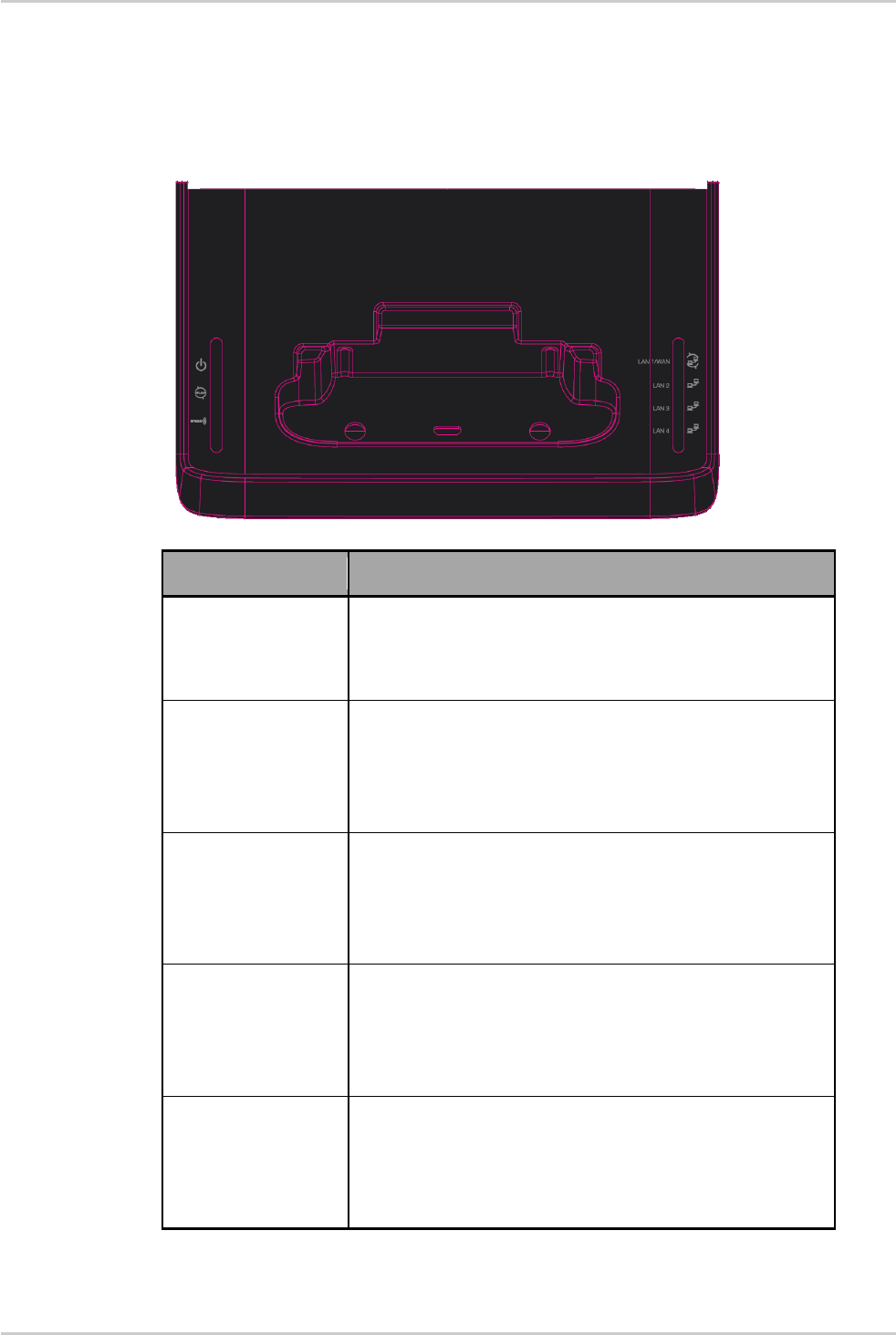
Introduction
Rev 1 Feb. 2012 13
LED Indicators
The NHD1W is designed to be placed on a desk top. All of the cables exit from the
rear for better organization. The display (visible on the top of the NHD1W) provides
information about network activity and the device status. See below for an
explanation of each of the indicator lights.
Led Indicator
Definition
Power
Power status indicator:
Off = No Power
On = Power
WLAN
Wi-Fi status indicator:
Off = Wi-Fi Off
Solid = Wi-Fi On, no traffic
Flash = Wi-Fi On, data traffic
WWAN
Internet WAN indicator:
Off = No Internet connection
Solid = Internet connected, no traffic
Flash = Internet connected, data traffic
LAN1 / WAN
LAN1/WAN Port connection status indicators:
Off = No cable connection
Solid = Cable connection established
Flash = Data traffic
LAN2
LAN3
LAN4
LAN 2-4 Port connection status indicators:
Off = No cable connection
Solid = Cable connection established
Flash = Data traffic
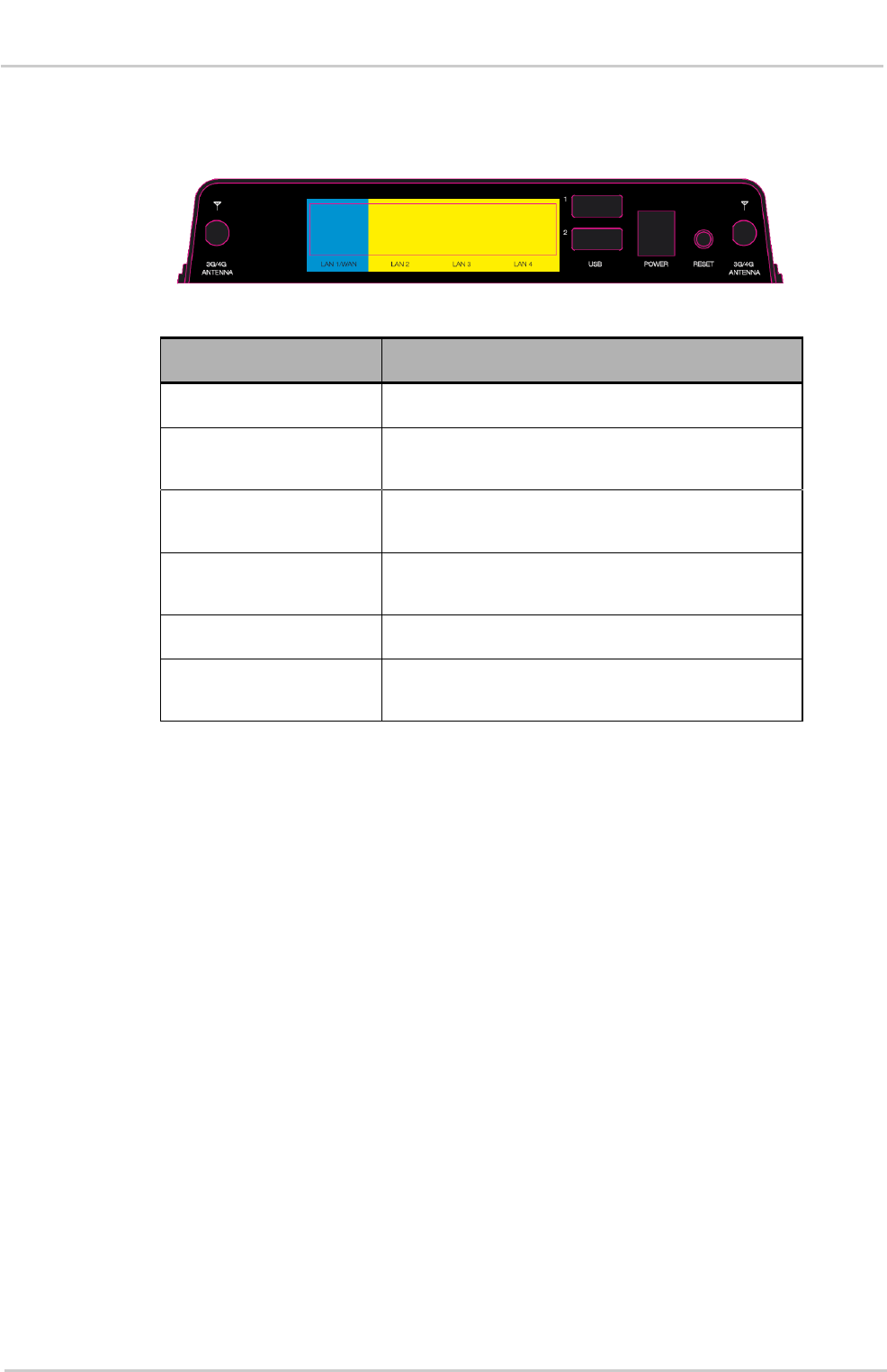
14 2400164
NHD1W User Guide
Interfaces
The following interfaces are available on the rear panel of the NHD1W:
Interface
Function
3G/4G antenna connectors
Attach external 3G/4G antennas
LAN 1 / WAN
LAN or WAN port for wired Ethernet clients or bridged
devices (for example, ADSL modem)
LAN 2 - 4
LAN Port for wired Ethernet clients (computers, laptops,
etc.)
USB ports
Connect a USB storage device to share content with
connected clients
Power connector
Connects to a DC 12V/2A power adapter
Reset
Hold this button down for over 12 seconds to reset to
factory defaults
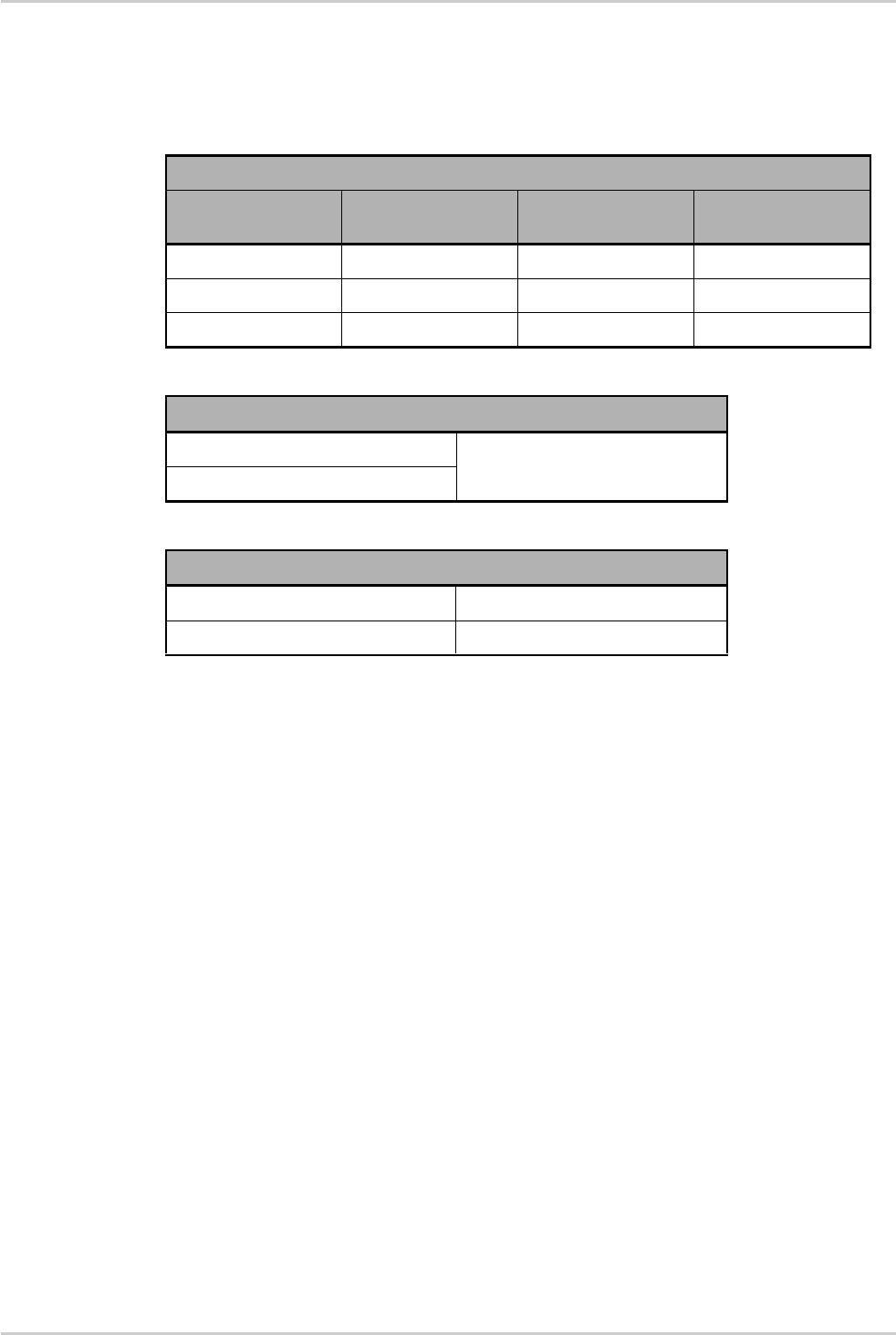
Introduction
Rev 1 Feb. 2012 15
Default Settings
The following tables list the default settings for the NHD1W. Note that these default
settings may change, once the AirCard mobile hotspot is docked in.
LAN (Management)
Easy mode
Small Home / Office
mode
Power User mode
Static IP Address
192.168.1.254
192.168.2.1
192.168.2.1
Subnet Mask
255.255.255.0
255.255.255.0
255.255.255.0
Default Gateway
192.168.1.1
192.168.2.1
192.168.2.1
Wireless LAN (Wi-Fi)
SSID (NHD1W)
Displayed on AirCard mobile
hotspot’s LCD screen.
Security Key (NHD1W)
Web interface access (Power User mode only)
Username
admin
Password
admin

16 2400164
NHD1W User Guide

Rev 1 Feb. 2012 17
2: Get Started
Placement of your NHD1W
Just like your mobile phone, the NHD1W’s location will affect its signal strength to the
3G/4G base station (cell tower). The data speed achievable from the NHD1W is
dependent on this signal strength, which is affected by many environmental factors.
When choosing a location for your NHD1W, keep in mind that the NHD1W needs
adequate signal strength to provide Internet connectivity.
Similarly, the wireless connection between your NHD1W and your Wi-Fi devices is
stronger the closer your devices are to your NHD1W. Your wireless connection and
performance will degrade as the distance between your NHD1W and devices
increases. This may or may not be directly noticeable, and is greatly affected by the
individual installation environment.
If you have concerns about your network’s performance that might be related to
range or obstruction factors, try moving the devices to a position between three to five
meters from the NHD1W to see if distance is the problem.
If you experience difficulties connecting wirelessly between your Wi-Fi devices and
your NHD1W, try the following steps:
In multi-story homes, place the NHD1W on a floor that is as close to the
centre of the home as possible. This may mean placing the NHD1W on an
upper floor.
Avoid placing the NHD1W near a cordless telephone that operates at the
same radio frequency as the NHD1W (2.3 GHz / 4 GHz).
Avoid Obstacles and Interference
Avoid placing your NHD1W near devices that may emit radio “noise,” such as
microwave ovens. Dense objects that can inhibit wireless communication include:
Refrigerators
Washers and dryers
Metal cabinets
Large aquariums
Metallic-based, UV-tinted windows
Note: While some of the items listed above can affect network performance, they will not
prohibit your wireless network from functioning; if you are concerned that your network is
not operating at its maximum effectiveness avoid placing your NHD1W near the devices
listed. Please ensure that your NHD1W’s 3G/4G external antenna is positioned vertically
(toward the ceiling).

18 2400164
NHD1W User Guide
If your wireless signal seems weak in some spots, make sure that objects such as
those listed above are not blocking the signal’s path (between your devices and the
NHD1W).
Cordless Phones
If the performance of your wireless network is impaired after considering the above
issues, and you have a cordless phone:
Try moving cordless phones away from your NHD1W and your wireless-
enabled computers.
Unplug and remove the battery from any cordless phone that operates on the
2.3 GHz / 4 GHz band (check manufacturer’s information). If this fixes the
problem, your phone may be interfering with the NHD1W.
If your phone supports channel selection, change the channel on the phone
to the farthest channel from your wireless network. For example, change the
phone to channel 1 and move your NHD1W to channel 11. See your phone’s
user manual for detailed instructions. If necessary, consider switching to a
900 MHz or 5 GHz cordless phone.
Choose the “Quietest” Channel for your
Wireless Network
In locations where homes or offices are close together, such as apartment buildings
or office complexes, there may be wireless networks nearby that can conflict with
your wireless network. Use the Site Survey capabilities found in the software provided
with your wireless adapter to locate any other wireless networks that are available
(see your wireless adapter’s user manual), and switch your NHD1W and computers
to a channel as far away from other networks as possible. Refer to section Wireless
LAN (WLAN) on page 40.
Experiment with more than one of the available channels, to find the clearest
connection and to avoid interference from neighbouring cordless phones or other
wireless devices.
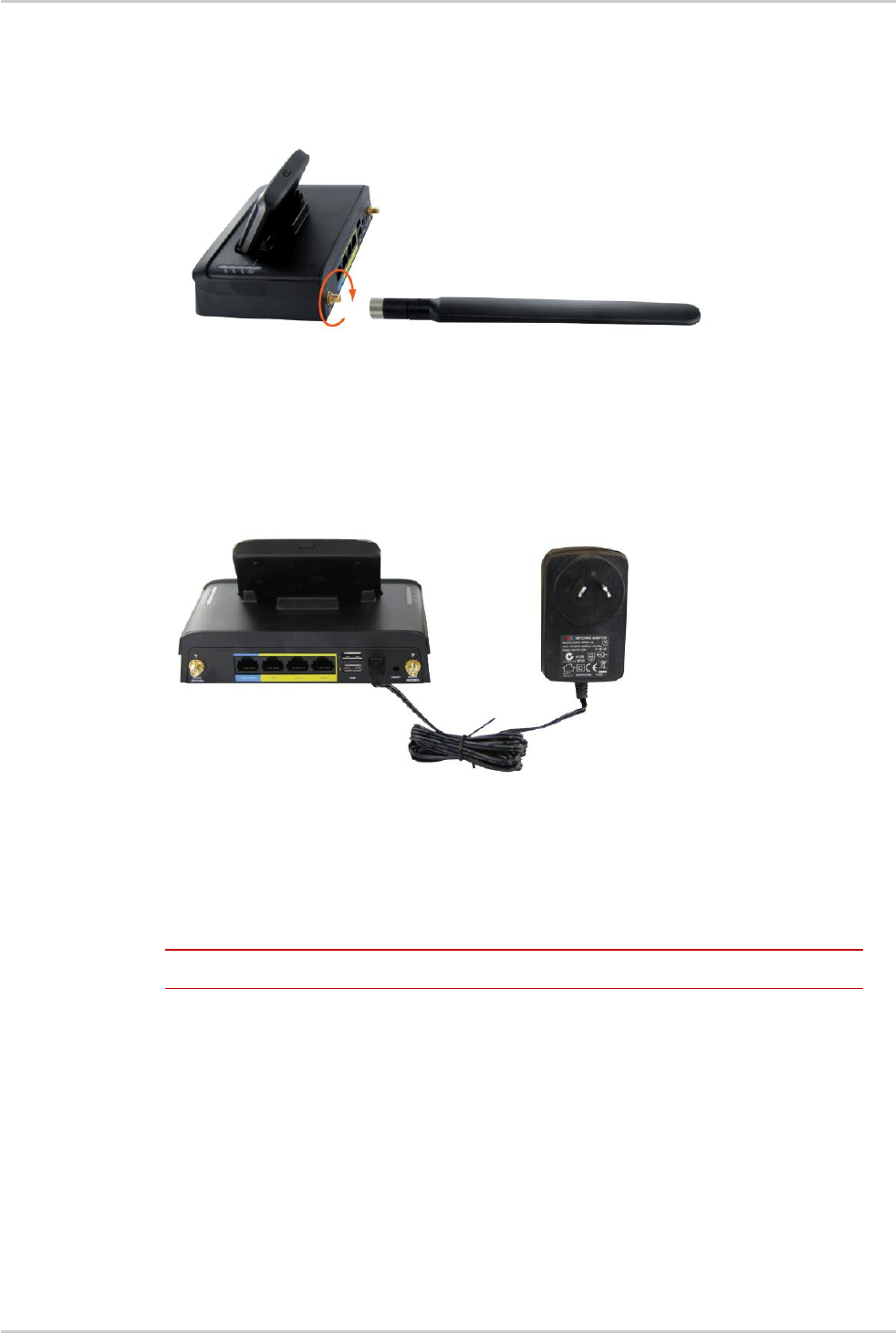
Get Started
Rev 1 Feb. 2012 19
Hardware Installation
1. Attach the supplied antennas to the ports marked “3G/4G ANTENNA”. [Attach in
a clockwise direction, as shown by the red arrow in the photo below.]
2. Turn the metal part to screw in the antenna until it tightens, then hold the metal
part while turning the antenna to a vertical position.
3. Connect the power adapter to the POWER socket on the back of the NHD1W.
Plug the power adapter into the wall socket. The WLAN and WWAN LEDs blink
for approximately 30 seconds while the NHD1W boots up.
4. Follow the instructions provided with your AirCard mobile hotspot to connect to
the Internet. Then dock the AirCard mobile hotspot into the NHD1W.
You are ready to use the NHD1W!
Note: Without the AirCard mobile hotspot, the NHD1W is not functional out of the box.

20 2400164
NHD1W User Guide
Connecting Wirelessly
1. Ensure Wi-Fi is enabled on your device (for example,
computer/laptop/smartphone/printer/camera).
2. Open the wireless network manager on your device and connect to the network
name shown on the LCD screen of your AirCard mobile hotspot.
3. When prompted for your wireless security settings, enter the Security Key shown
on the LCD screen of the AirCard mobile hotspot.
4. Wait approximately 30 seconds for the connection to establish.
After the setup process is completed, you will be connected to the Internet.
You can connect up to 16 Wi-Fi devices to your NHD1W.
Quick Wi-Fi Setup
Quick Wi-Fi Setup allows users to quickly connect to a Wi-Fi network without the use
of a keyboard. This is sometimes referred to as Wi-Fi Protected Setup (WPS). The
feature is available on many more recent products such as cameras, printers, smart
phones, and laptops.
1. Press the WPS button on your AirCard mobile hotspot docked in the NHD1W
until the WLAN LED on the NHD1W starts flashing.
2. Within 2 minutes press the WPS button on the wireless device you want to
connect or select the WPS-related option in the device’s software.
The NHD1W and your wireless device will communicate and establish the
connection.
Connecting via a Cable
1. Connect the provided Ethernet cable to the port marked LAN1/WAN, LAN 2,
LAN3 or LAN4 at the back of the NHD1W.
2. Connect the other end of the Ethernet cable to your computer.
3. Wait approximately 30 seconds for the connection to establish.
After the setup process is completed, you will be connected to the Internet.
You can connect up to 4 devices via Ethernet cable to the ports marked LAN1/WAN
or LAN 2-4.

Get Started
Rev 1 Feb. 2012 21
Accessing Storage Devices
The NHD1W provides access to the connected USB storage devices on USB ports 1
and 2, as well as the microSD card in the AirCard mobile hotspot.
Note: The microSD card in the AirCard mobile hotspot can be accessed via the NHD1W only if
the file sharing option in the AirCard mobile hotspot is configured for USB Tethered mode. See
the AirCard mobile hotspot’s user guide for configuring the file sharing option.
To access your storage devices:
1. Plug in your USB storage device.
2. If accessing the microSD card in the AirCard mobile hotspot, configure the file
sharing option to USB Tethered mode.
3. Make sure you are connected to the NHD1W via Ethernet LAN ports or via Wi-
Fi.
4. The method used to read/write the files in the storage devices depends on your
computer's operating system.
Windows
1. Open Windows Explorer.
2. Type the network address \\swi.hub in the address bar to see the connected
storage devices. The storage devices will be labelled Disk A, Disk B or Disk C
for each of the connected devices.
You can now drag and drop (copy and paste) your files from or to the storage
devices.
Mac
1. In Mac, open up a Finder window.
2. Select Go -> Connect to Server.
3. Enter server address smb://swi.hub.
4. Select the volumes you want to mount on “swi.hub”. The storage devices will be
labelled Disk A, Disk B or Disk C.
Linux
In Linux machine, you can see the storage devices (SMB shares) using smbclient
program (for example, smbclient –L swi.hub command will list the shares available).
Smartphones
Several Samba client applications are available for accessing the connected storage
devices. You can download and install them; please see the manual or the
manufacturer's web site of the storage device.

22 2400164
NHD1W User Guide
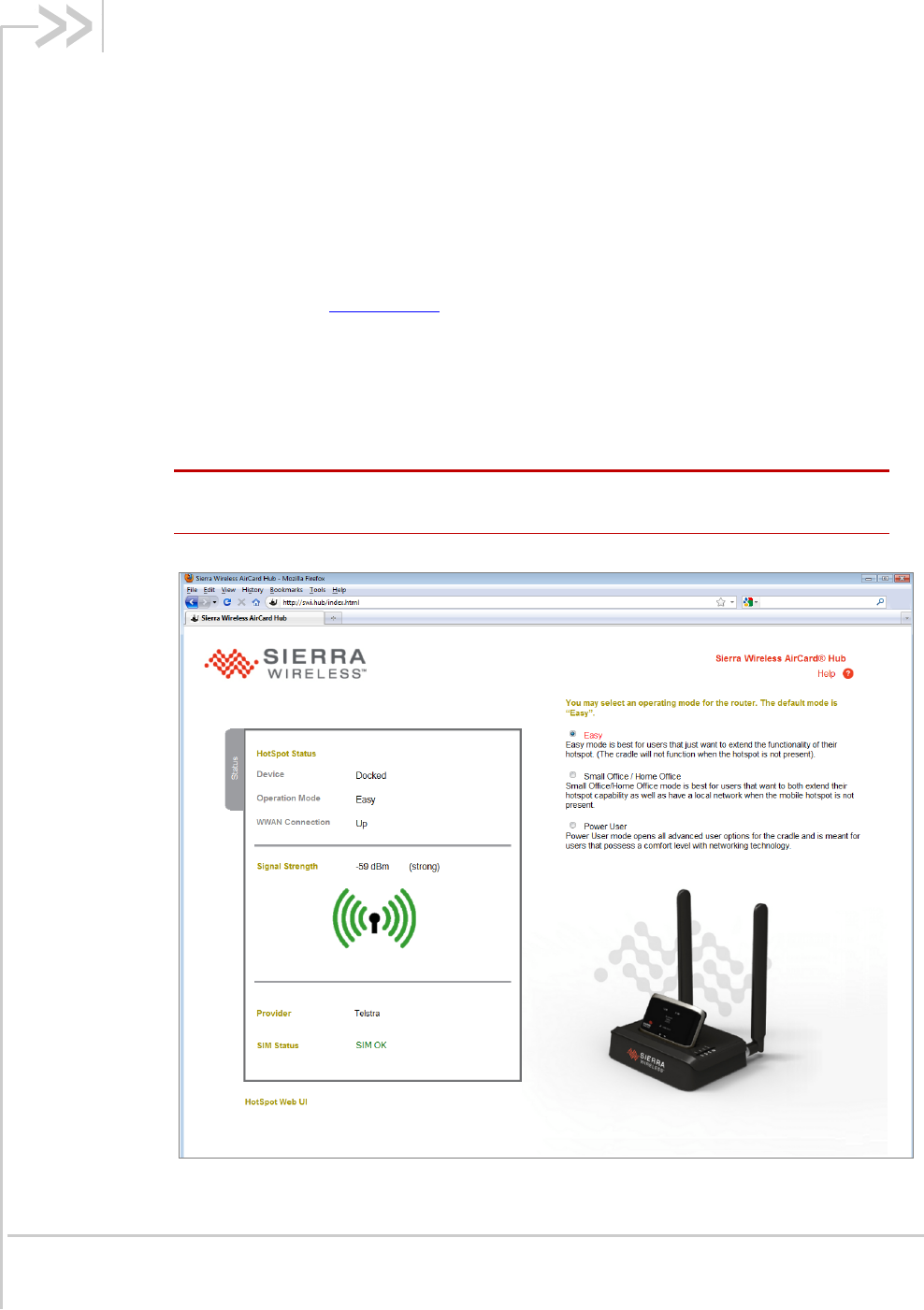
Rev 1 Feb. 2012 23
3: Operating Modes
The NHD1W has 3 operating modes offering varying levels of function and
configuration options.
Easy (default)
Small Office / Home Office
Power User
You can select the operating mode from the NHD1W homepage. Regardless of the
operating mode selected, any device connected to the NHD1W can access it by
using the address http://swi.hub. This opens the management console, where you
can:
View the status of the NHD1W.
Make changes to the NHD1W, including changing the operating mode.
Access the AirCard mobile hotspot’s homepage.
Note: Refer to the Default Settings (page15) for the default IP Address in use in each of the
operating modes.
Figure 1: NHD1W Homepage – Basic Status Page
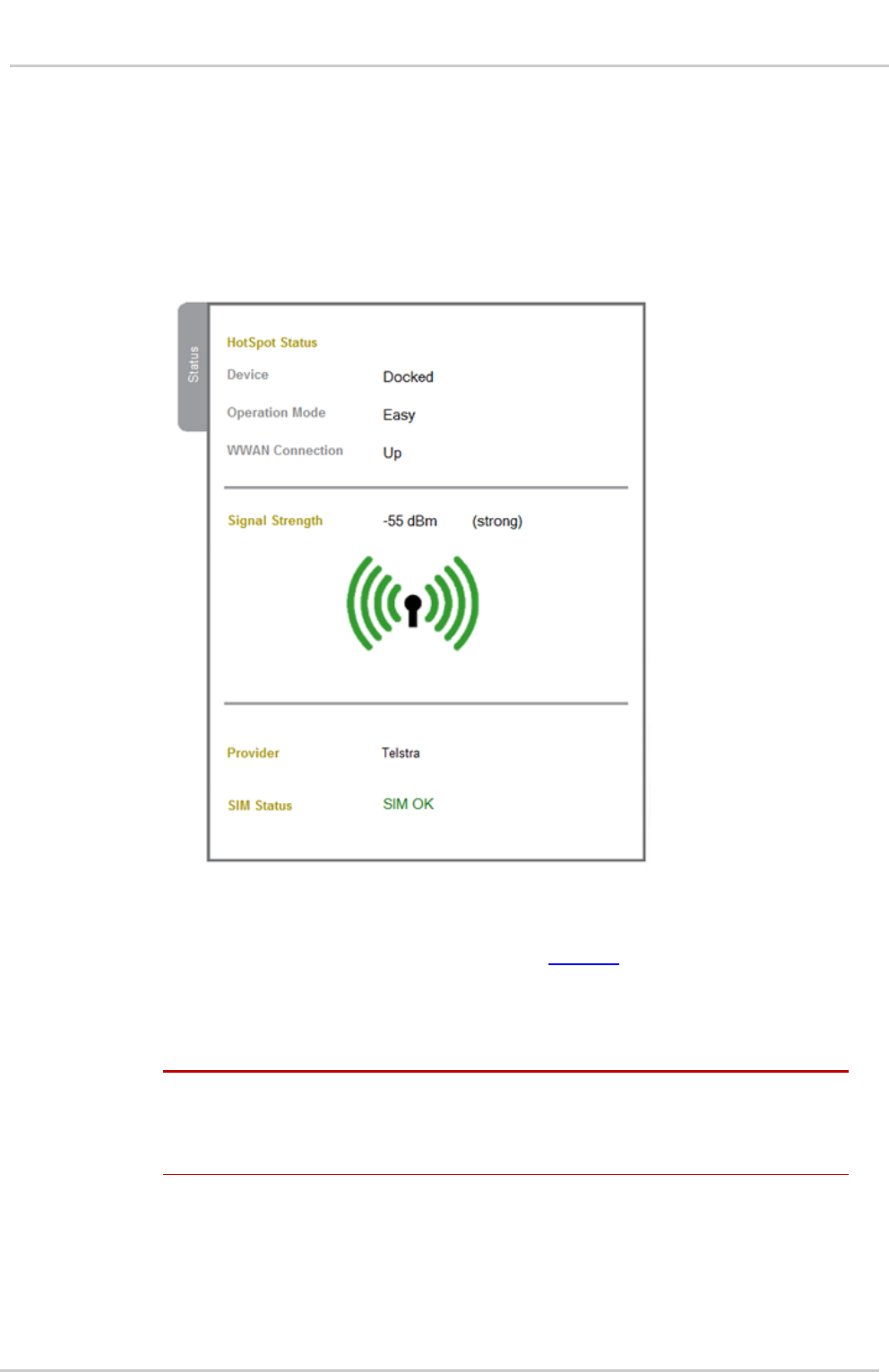
24 2400164
NHD1W User Guide
Easy Mode
Easy mode uses the settings of the docked AirCard mobile hotspot. In this mode you
are only able to view the status of the Internet connection through the hotspot.
The status tab provides basic connection related information, such as AirCard mobile
hotspot dock status, WWAN connection status, 3G/4G signal strength (dBm), current
3G/4G provider, the SIM status.
Figure 2: Easy mode – Status Tab
The NHD1W also provides access to any connected USB storage devices. These
can be accessed by using the network address: \\swi.hub.
In Easy mode, the Ethernet LAN ports are activated only when the AirCard mobile
hotspot is docked.
Note: In Easy mode, the Wireless Network SSID is the same as the SSID of the AirCard mobile
hotspot. Connecting to this wireless network provides access to the Internet connection
through the docked AirCard mobile hotspot. The IP Address assigned to the NHD1W is in the
same subnet as that of the AirCard mobile hotspot.
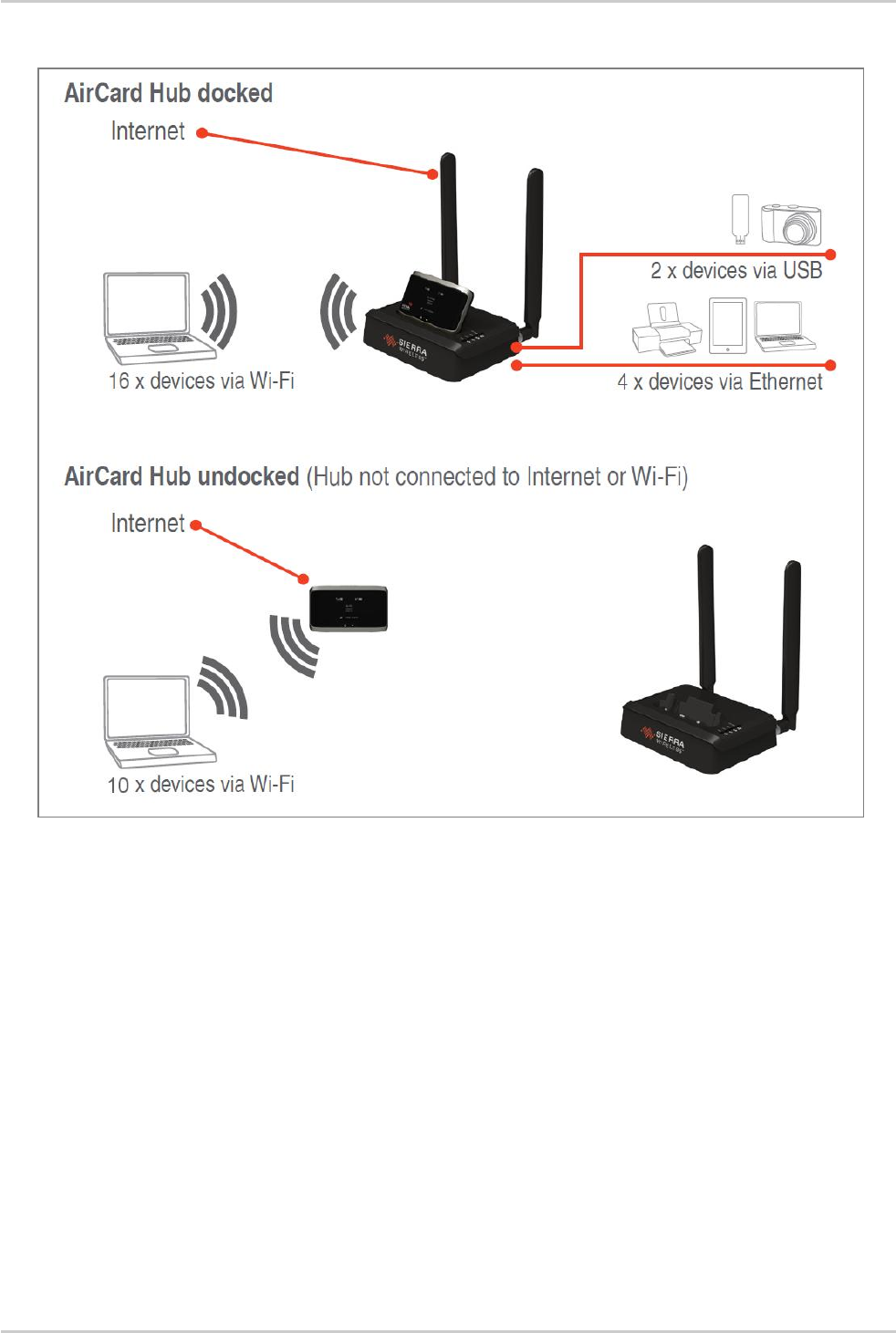
Operating Modes
Rev 1 Feb. 2012 25
Figure 3: Easy Mode – NHD1W Docked/Undocked Scenarios
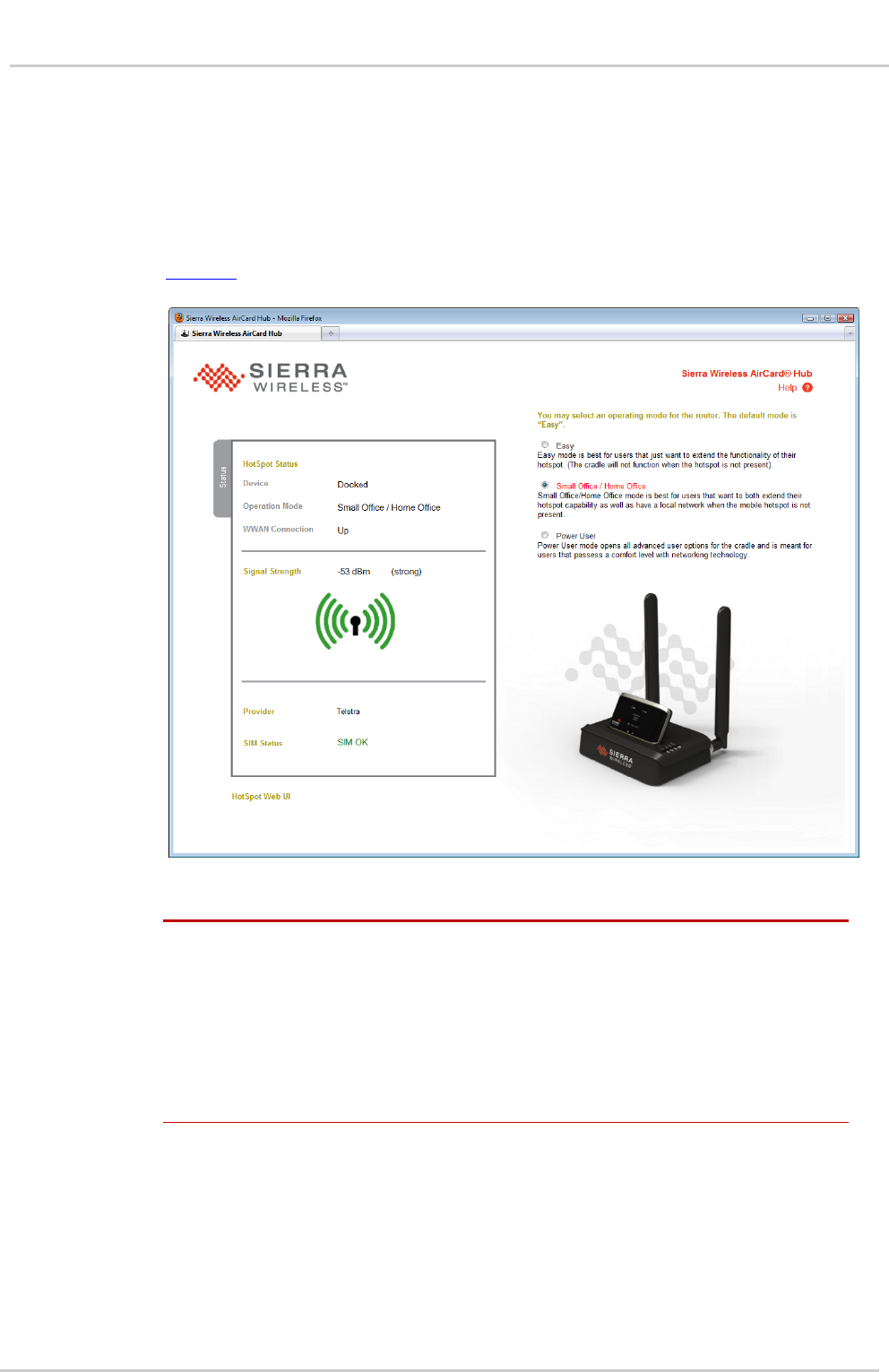
26 2400164
NHD1W User Guide
Small Office / Home Office
Small Office / Home Office (SOHO) mode also uses the settings on the docked
AirCard mobile hotspot.
In Small Office / Home Office mode, the NHD1W also offers a standalone wireless
network that provides access to any connected USB storage devices. These can be
accessed by both Ethernet and wireless users by using the network address:
\\swi.hub.
Figure 4: SOHO Mode – Basic Status Page
Note: In Small Office / Home Office mode, the wireless network SSID of the NHD1W is the
AirCard mobile hotspot’s SSID with ‘-C’ or ‘_C’ added at the end. The IP Address assigned to
the NHD1W is based on the AirCard mobile hotspot’s IP address, with the subnet incremented
by 1.
Connecting to this wireless network provides access to the attached USB storage devices.
Internet access is provided by the docked AirCard mobile hotspot. If the AirCard mobile
hotspot is undocked, Internet access is only available by connecting to the AirCard mobile
hotspot’s SSID.
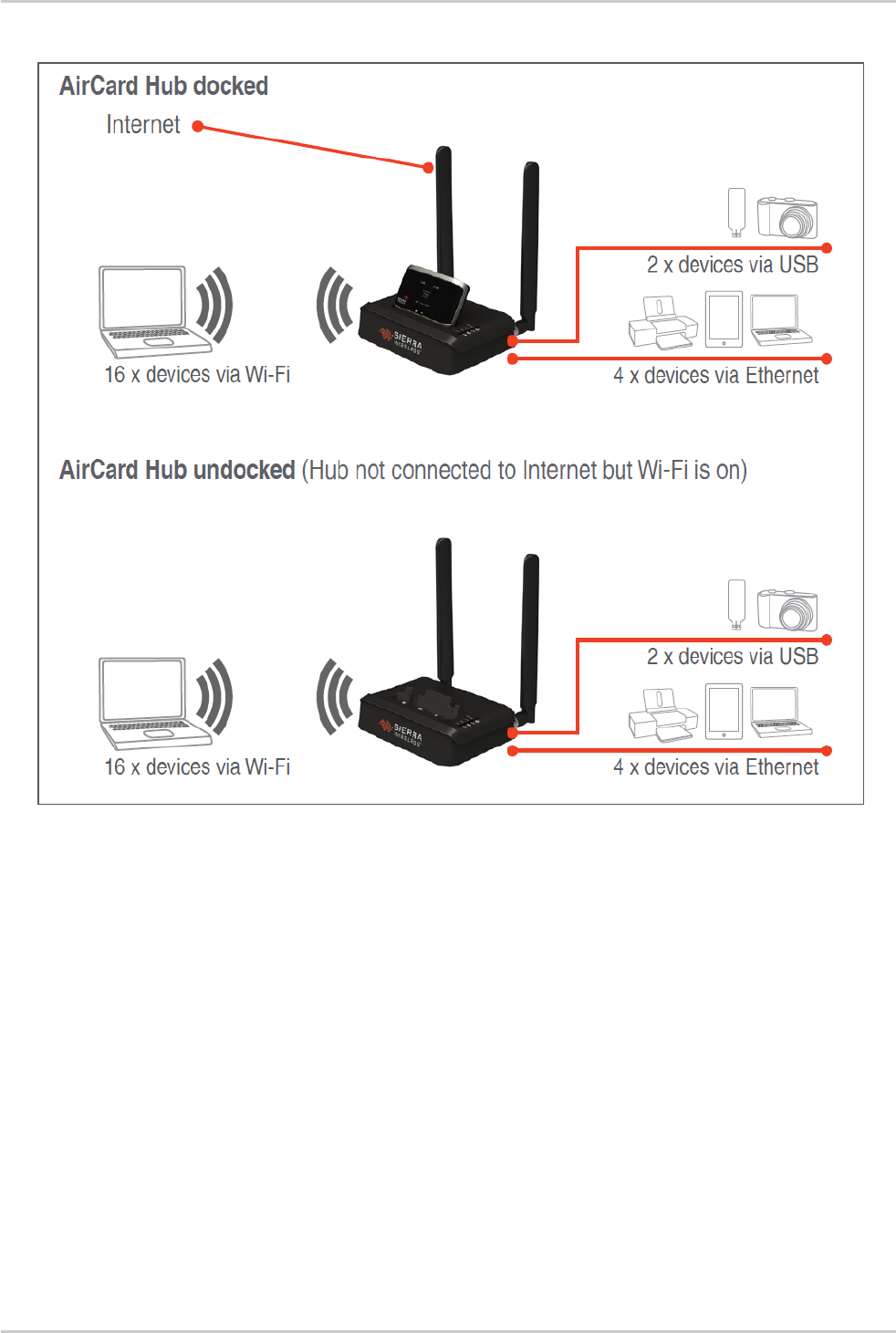
Operating Modes
Rev 1 Feb. 2012 27
Figure 5: SOHO Mode – NHD1W Docked/Undocked Scenarios
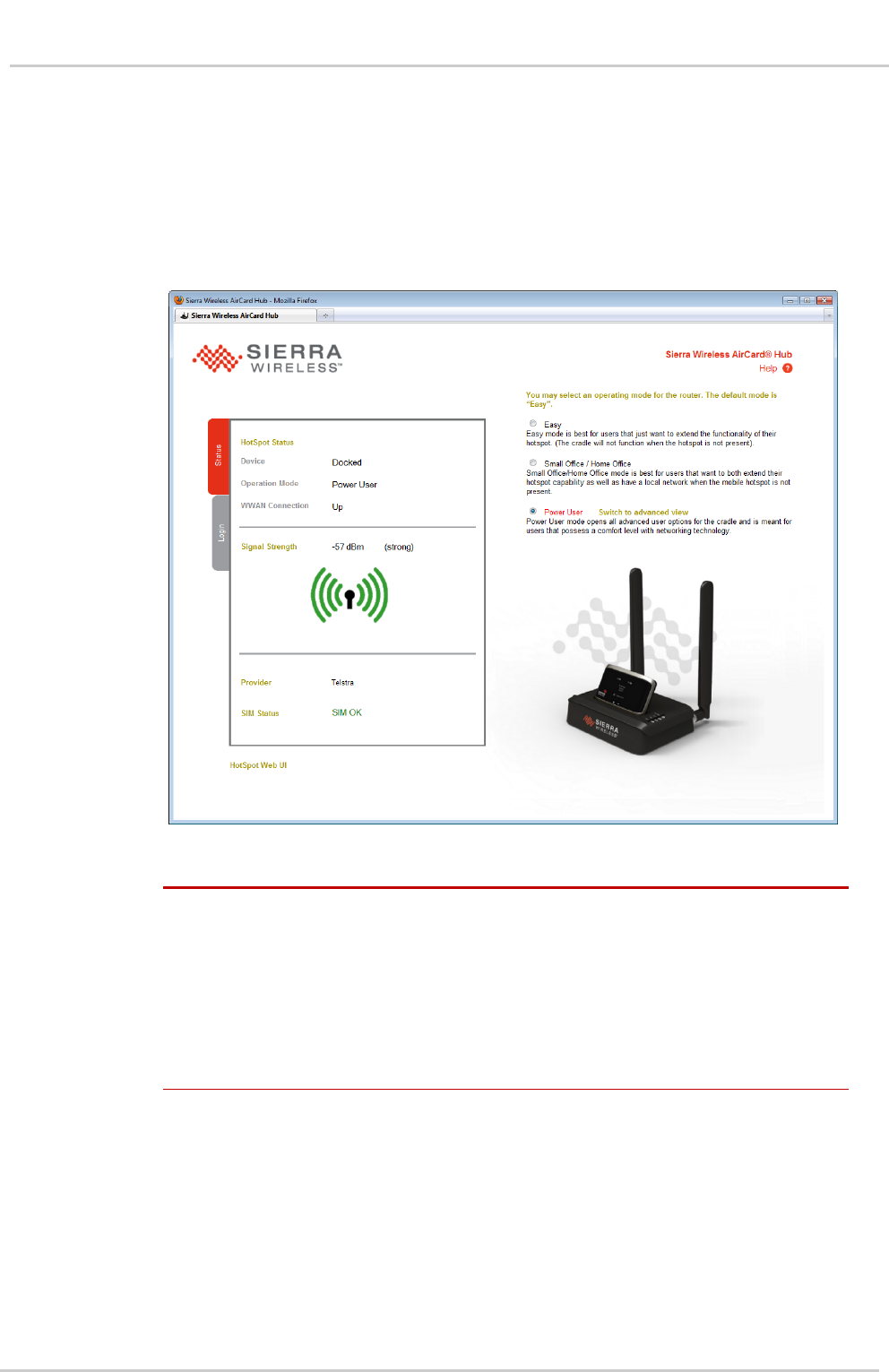
28 2400164
NHD1W User Guide
Power User
Power User mode also uses the settings on the docked mobile hotspot. In this mode,
however, you can also configure the basic wireless network settings, WAN port
function as well as in-depth configuration options for the NHD1W.
You can use the WAN port to connect the NHD1W to an ADSL modem or other xDSL
device to provide access to the Internet.
Figure 6: Power User – Basic Status Page
Note: In Power User mode, the wireless network SSID of the NHD1W is the AirCard mobile
hotspot’s SSID with ‘-C’ or ‘_C’ added at the end. The IP Address assigned to the NHD1W is
based on the AirCard mobile hotspot’s IP address, with the subnet incremented by 1.
Connecting to this wireless network provides access to the attached USB storage devices.
Internet access is provided by the docked AirCard mobile hotspot. If the AirCard mobile
hotspot is undocked, Internet access is available by connecting to the AirCard mobile
hotspot’s SSID. Alternatively, LAN1/WAN port can be configured as WAN port to connect to
an ADSL modem or other xDSL device.
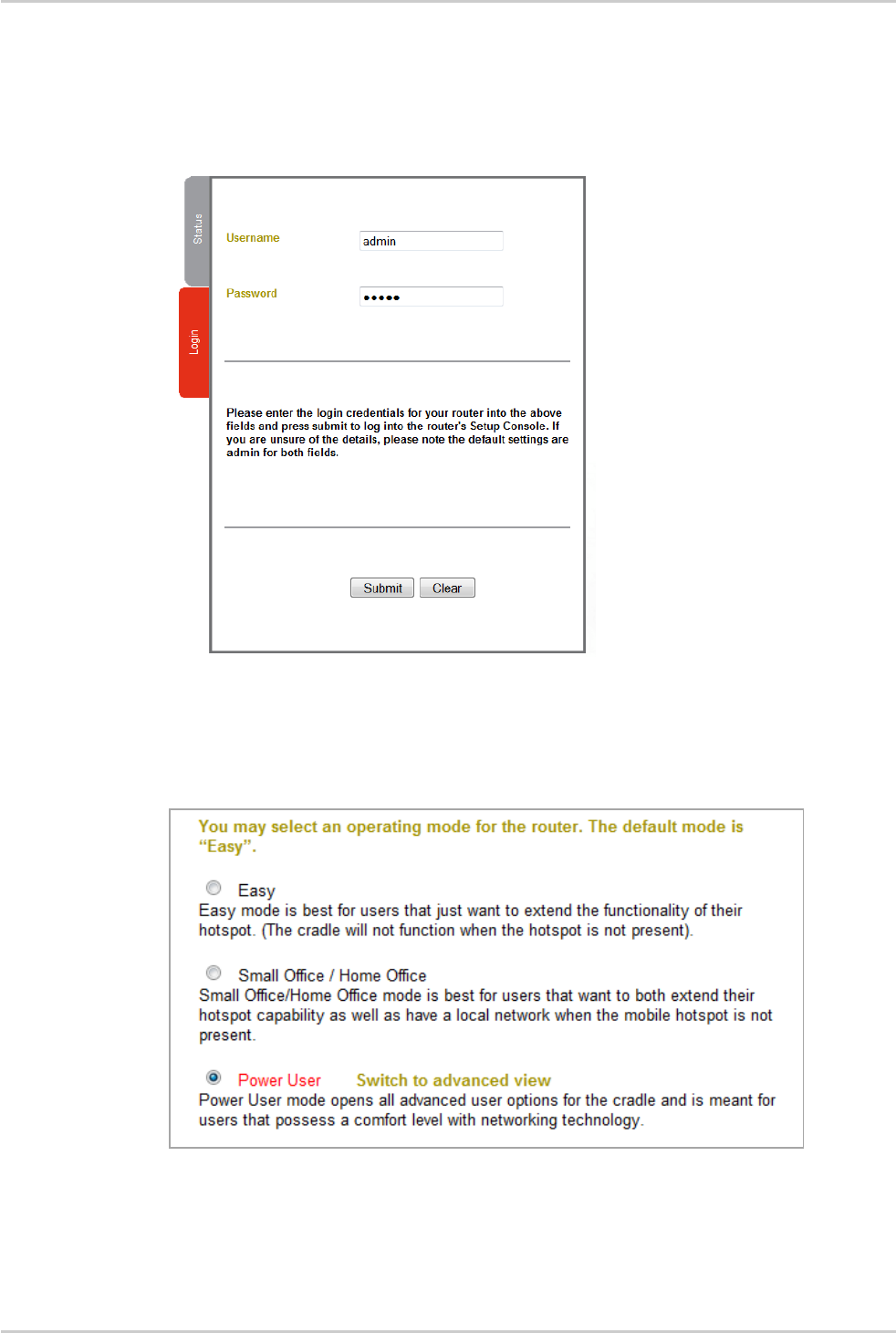
Operating Modes
Rev 1 Feb. 2012 29
Login Tab
In Power User mode, you will see the Login tab next to the Status tab. Click the Login
tab to access and configure advanced settings. Unless the administrator Username
and Password were previously changed, you can login with the default Username
and Password provided in Default Settings (page 15).
Figure 7: Power User – Login Tab
Alternatively, you can switch to the advanced view by clicking the “Switch to
advanced view” link that is displayed after you select Power User.
Figure 8: Power User – Switch to Advanced View
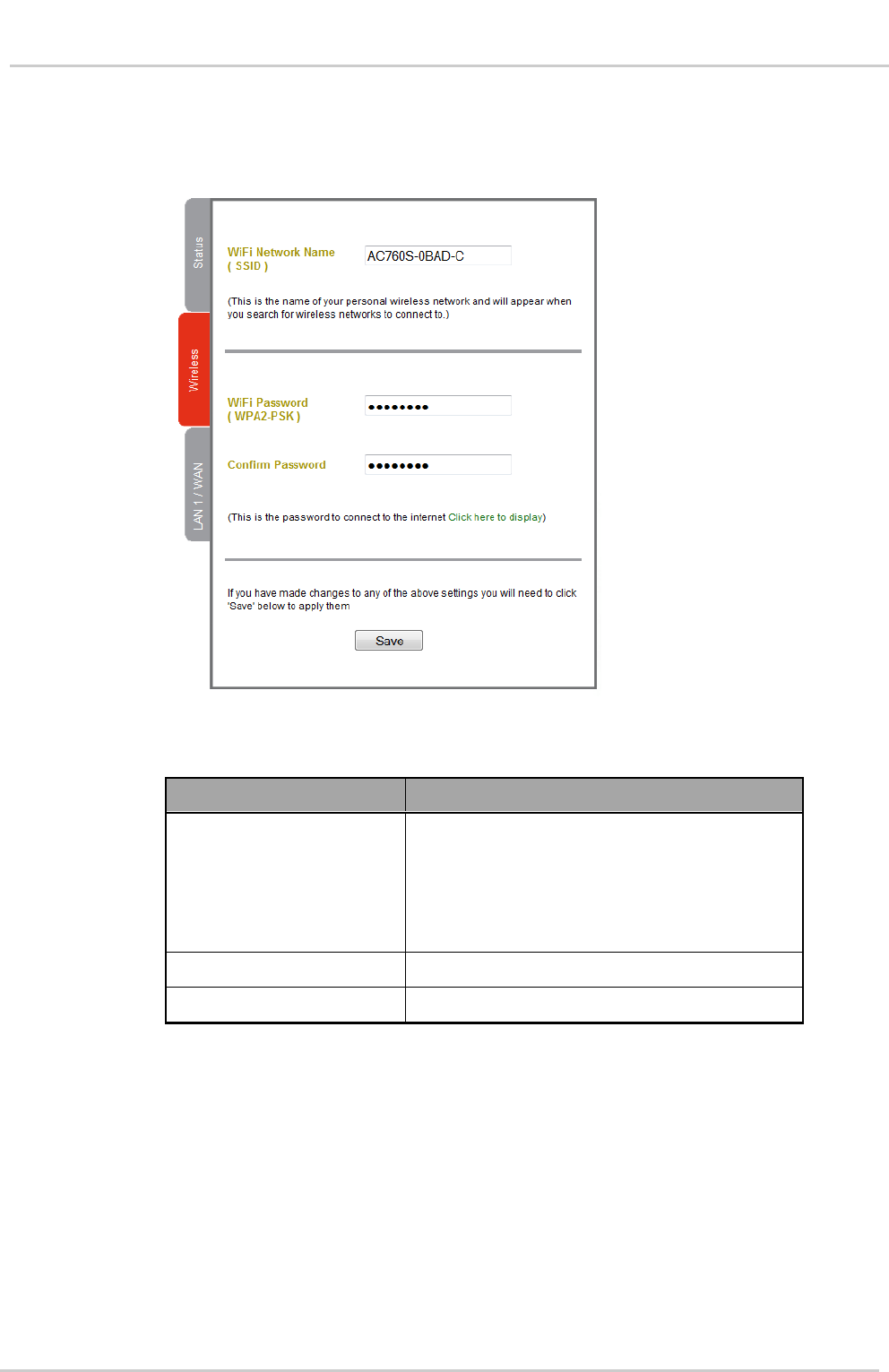
30 2400164
NHD1W User Guide
Wireless Tab
This tab allows you to configure basic Wi-Fi settings for this device, such as changing
the Wi-Fi Network Name (SSID) and Password.
Figure 9: Power User – Wireless Tab
Basic View - Wi-Fi settings
Field
Definition
Wi-Fi Network Name
(SSID)
The SSID (Service Set Identifier) is the name of
your wireless network. Use a unique name to
identify your wireless device so that you can
easily connect to it from your wireless clients.
This field is case sensitive and can be up to 32
characters.
Wi-Fi Password
Enter the password you would like to use.
Confirm Password
Retype the Wi-Fi password to confirm.
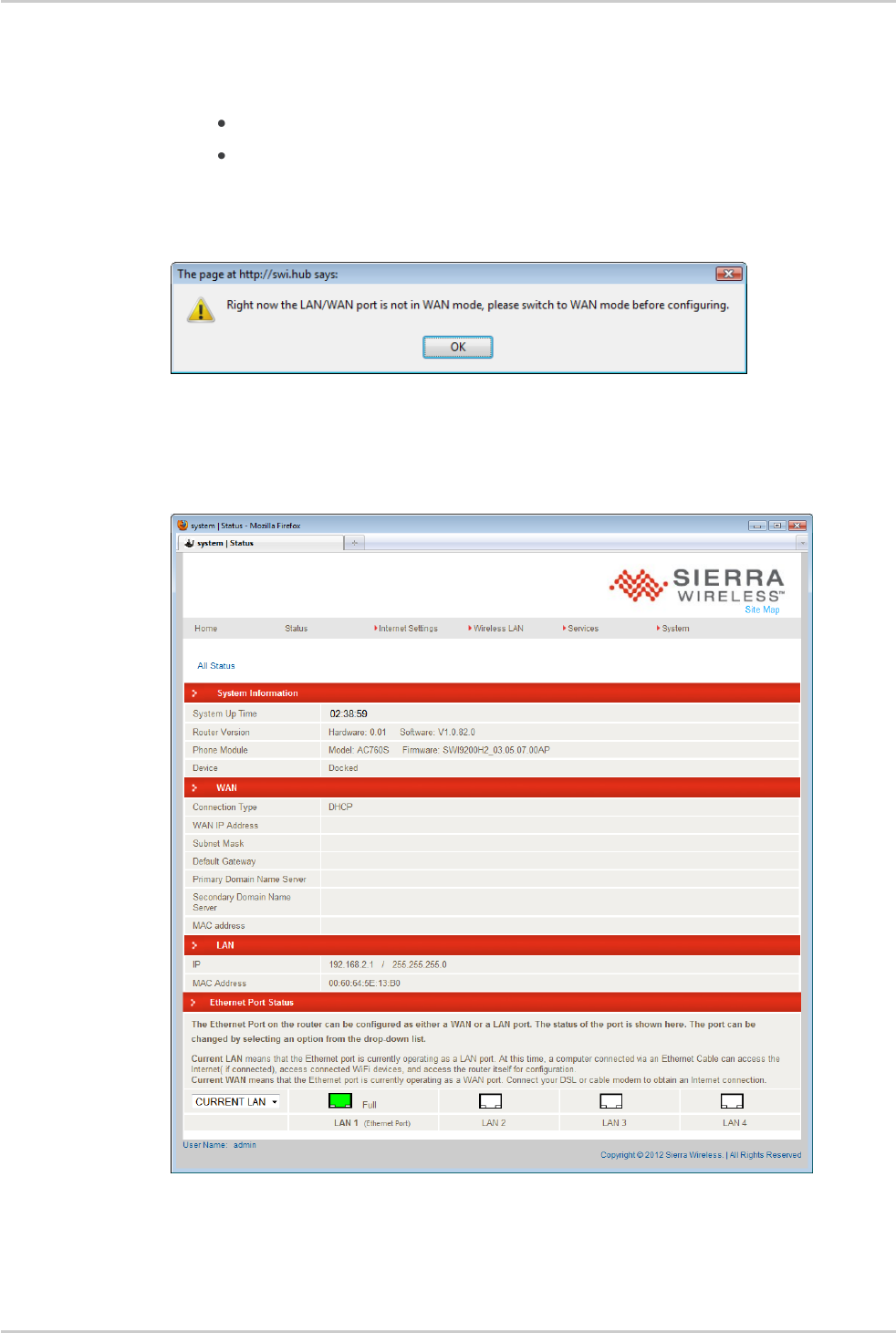
Operating Modes
Rev 1 Feb. 2012 31
LAN 1 / WAN Tab
This tab allows you to configure the WAN port function. You can select from the
following types of WAN connection:
DHCP (Automatic Configuration – default)
Static (fixed IP)
Unless the LAN1/WAN port was previously configured as WAN port, you will be
prompted with the following warning message.
Click OK to continue; the System Status page will open. From this page, in the
Ethernet Port Status section, you can select LAN1/WAN port to be a LAN port or
WAN port. Then click Home to go back to the basic status page and to continue
configuring your LAN1/WAN port.
Figure 10: Advanced View - Status
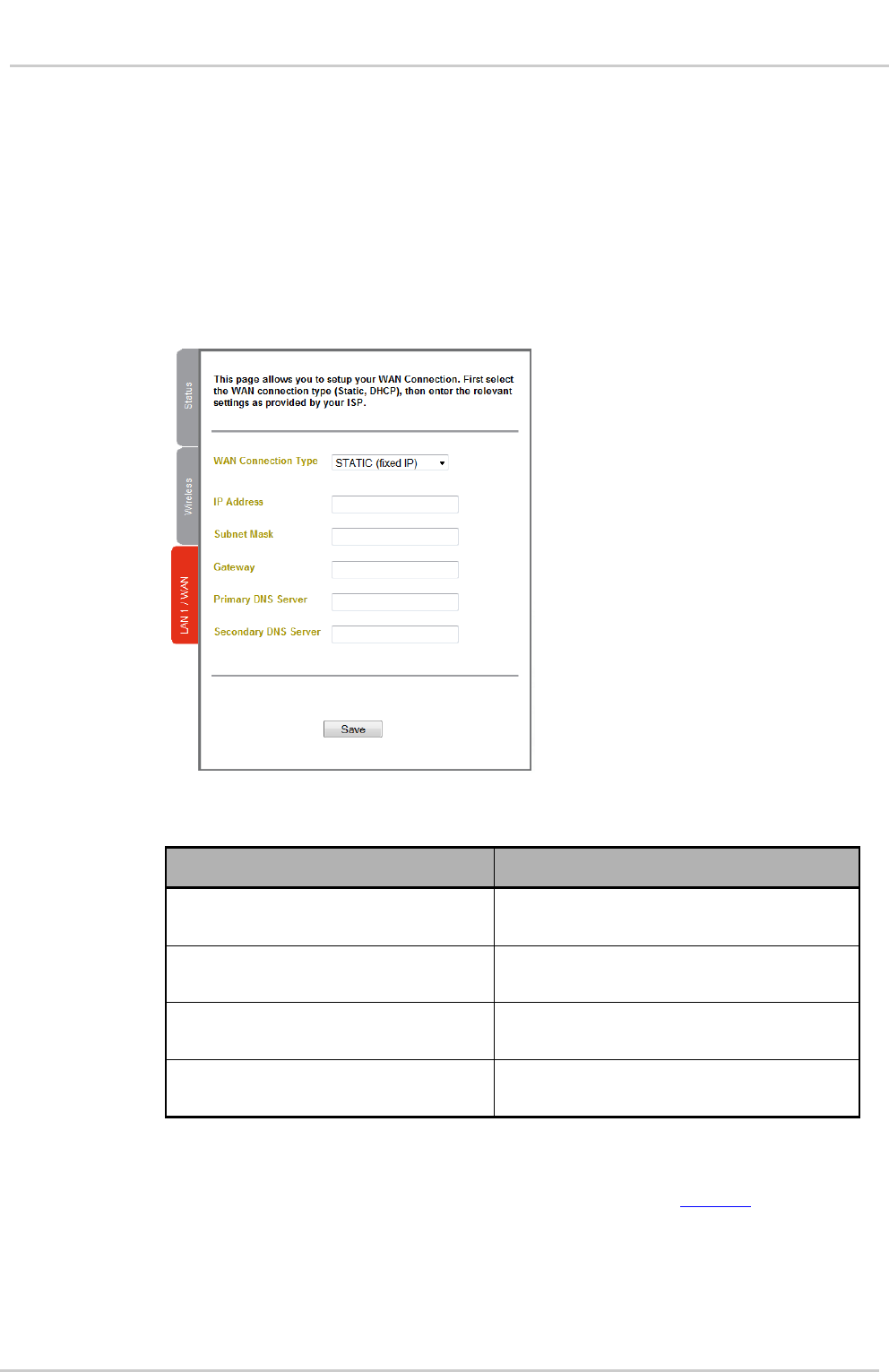
32 2400164
NHD1W User Guide
DHCP
The default setting is DHCP mode. In this mode network settings are automatically
configured via DHCP protocol for the existing connection offered by an ADSL modem
or xDSL device. To use this, select DHCP from the WAN Connection Type drop-down
menu and click Save.
STATIC (Fixed IP)
With Static (Fixed IP) mode, you must enter the network information for the
connection. To use this, select STATIC (fixed IP) from the WAN Connection Type
drop-down menu, enter the required IP Networking information, and then click Save.
Figure 11: Power User - LAN1/WAN Tab
Field
Definition
IP Address
Enter the IP Address the NHD1W will use for
the WAN port connection.
Subnet Mask
Enter the Subnet Mask the NHD1W will use for
the WAN port connection.
Gateway
Enter the Gateway IP Address the NHD1W will
use for the WAN port connection.
Primary / Secondary DNS Server
Enter the DNS Server IP Addresses the
NHD1W will use for the WAN port connection.
In Power User mode, the NHD1W also offers a standalone wireless network that
provides access to any connected USB storage devices. These can be accessed by
both Ethernet and wireless users by using the network address: \\swi.hub.
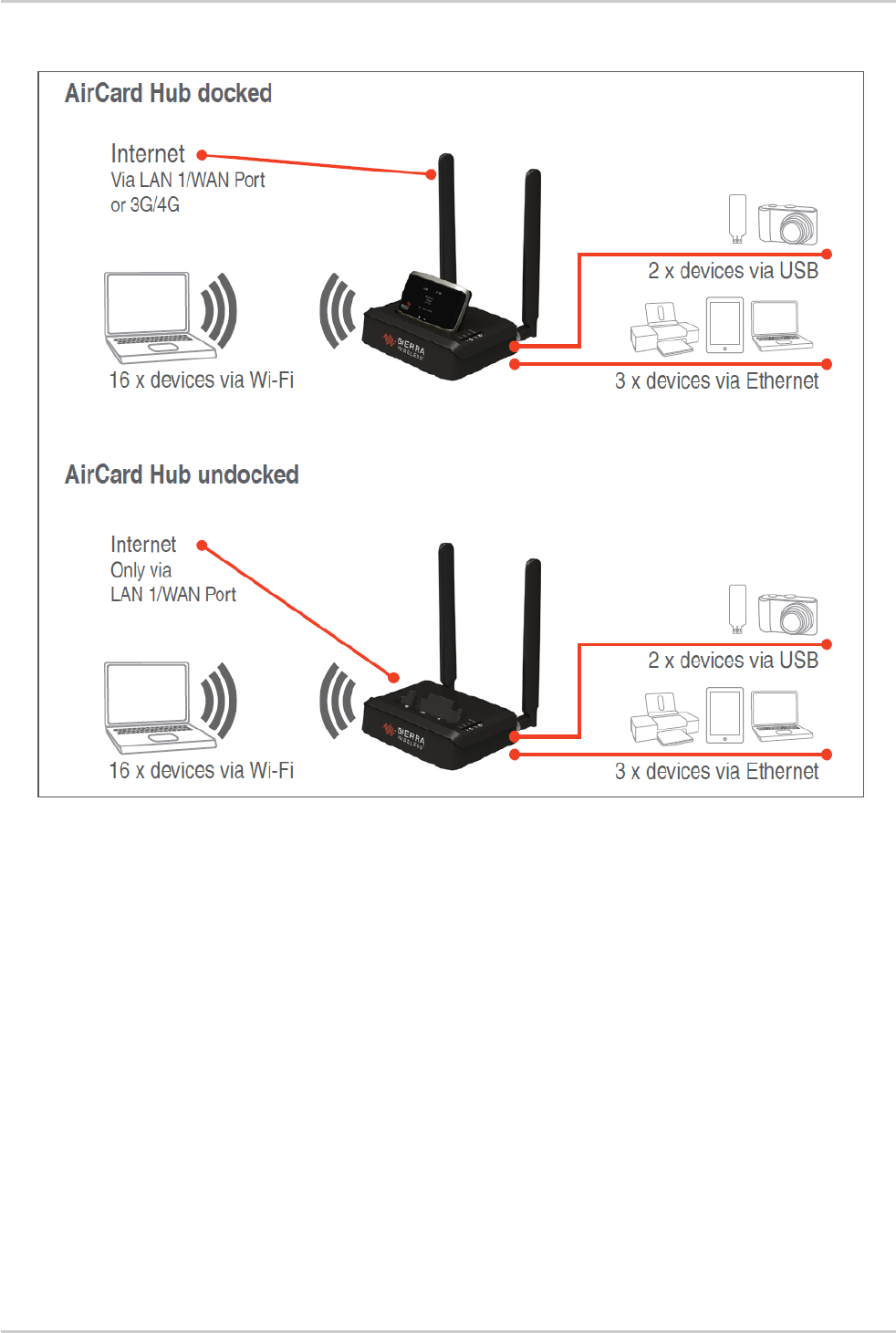
Operating Modes
Rev 1 Feb. 2012 33
Figure 12: Power User Mode – NHD1W Docked/Undocked Scenarios

34 2400164
NHD1W User Guide

Rev 1 Feb. 2012 35
4: Advanced Settings
The advanced settings pages are displayed only when the NHD1W is in “Power User”
mode.
These pages provide a more in-depth ability to configure the NHD1W.
Home
Click the Home menu item to return you to the basic status page.
Status
The status page as shown in Figure 10 on page 31 provides system related
information of the NHD1W. By default, the status page shows System Information,
WAN, LAN and Ethernet Port Status. Each section shows information relevant to the
connection type or function.
If the LAN, WAN or Ethernet Port status is hidden, click the relevant link below the
menu bar. To view all the status page items, click the All Status button.
LAN1/WAN port
The LAN1/WAN port can also operate as a WAN port for connecting to a bridged
Ethernet device, such as an xDSL modem. Use the drop-down menu to select the
LAN or WAN mode applicable for your environment.
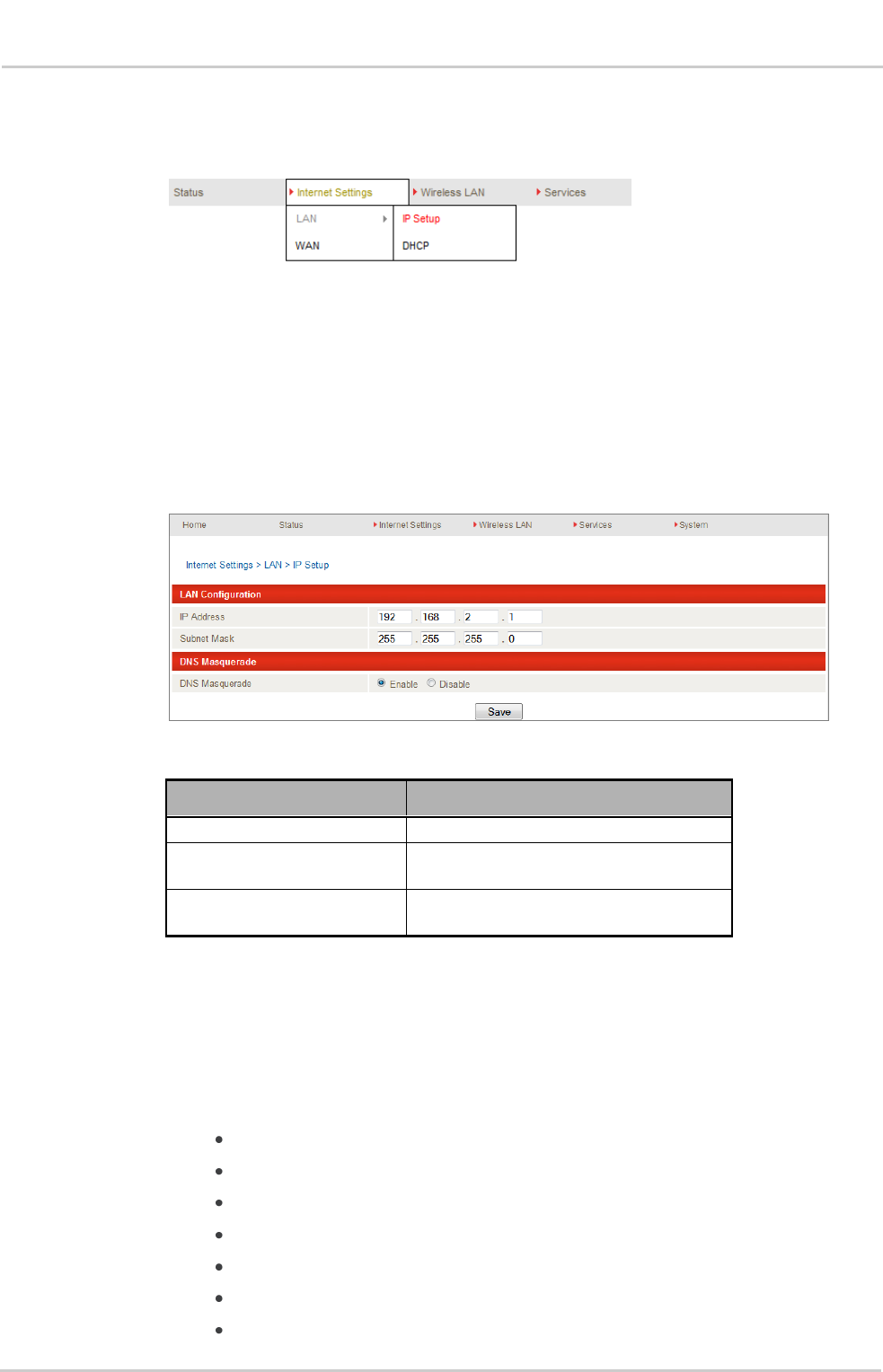
36 2400164
NHD1W User Guide
Internet Settings
Select the Internet Settings menu to configure LAN or WAN settings.
LAN Configuration
The LAN drop-down menu item allows you to display the IP Setup and DHCP
settings.
IP Setup
From this page you can configure the LAN functionality of the NHD1W. You can
change the LAN IP Address, LAN Subnet Mask and DNS Masquerading options.
Figure 13: Advanced View - LAN Settings
Name
Description
IP Address
The local IP address of NHD1W
Subnet Mask
The subnet mask for the local
network.
DNS Masquerade
Select to enable or disable DNS
masquerading for connected clients.
Click Save to save the settings.
DHCP
From the DHCP page you can adjust the DHCP settings used by the NHD1W. The
DHCP settings are then passed onto any device connecting via DHCP. You can
manually set the following settings:
DHCP Start Range
DHCP End Range
DHCP Lease time
Default Domain Name Suffix
Primary and Secondary DNS Server
Primary and Secondary WINS Server
NTP Server (Option 42)
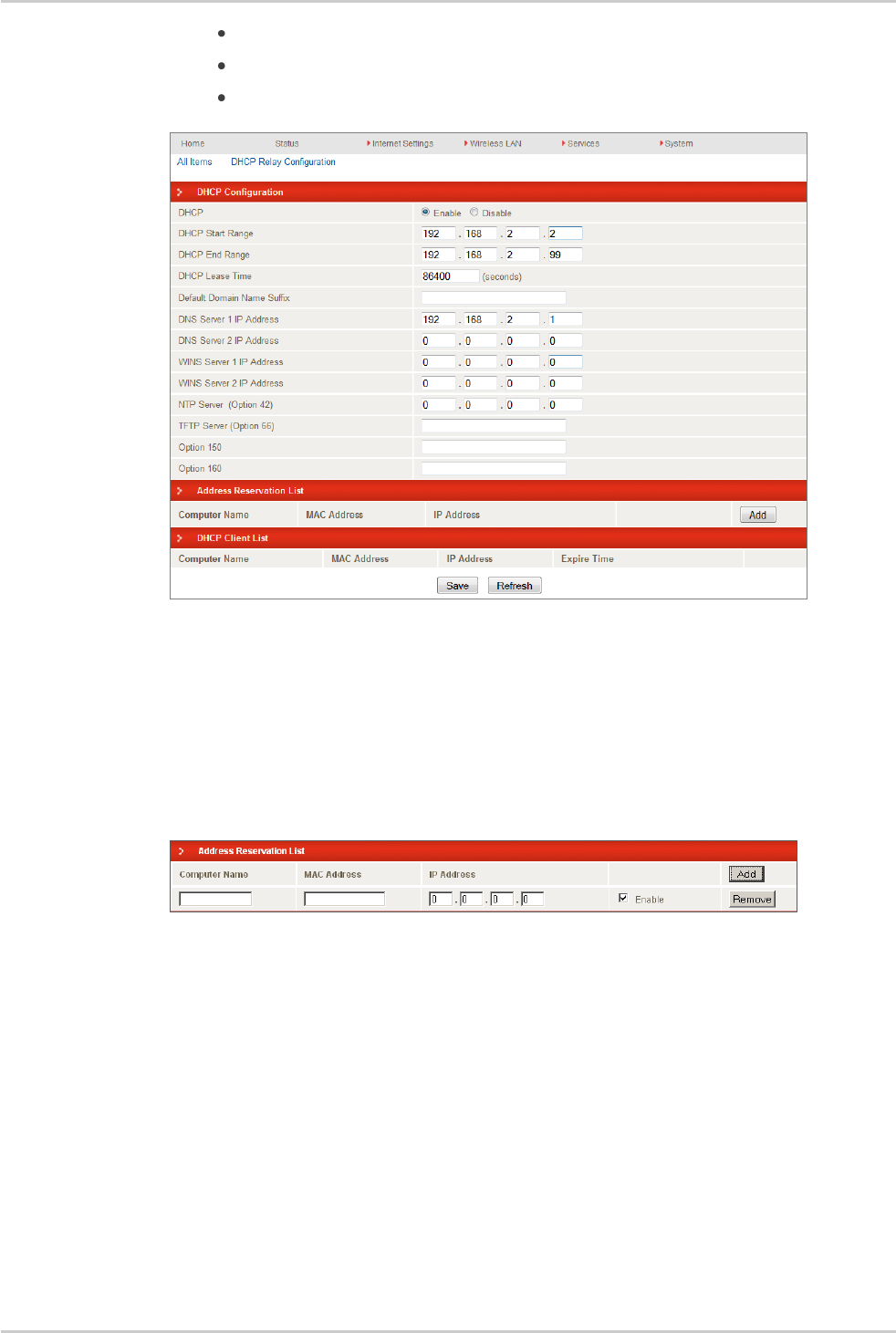
Advanced Settings
Rev 1 Feb. 2012 37
TFTP Server (Option 66)
Option 150
Option 160 (VoIP options)
Figure 14: DHCP Settings
After entering the applicable details, click Save.
You can also assign a particular IP address to a specific device every time that
device makes a DHCP request as follows:
1. Click Add.
Figure 15: DHCP Settings – Address Reservation List
2. Enter a name for the computer or device.
3. Enter the computer or device’s MAC address.
4. Enter the IP address to assign.
5. Click Save to apply the changes.
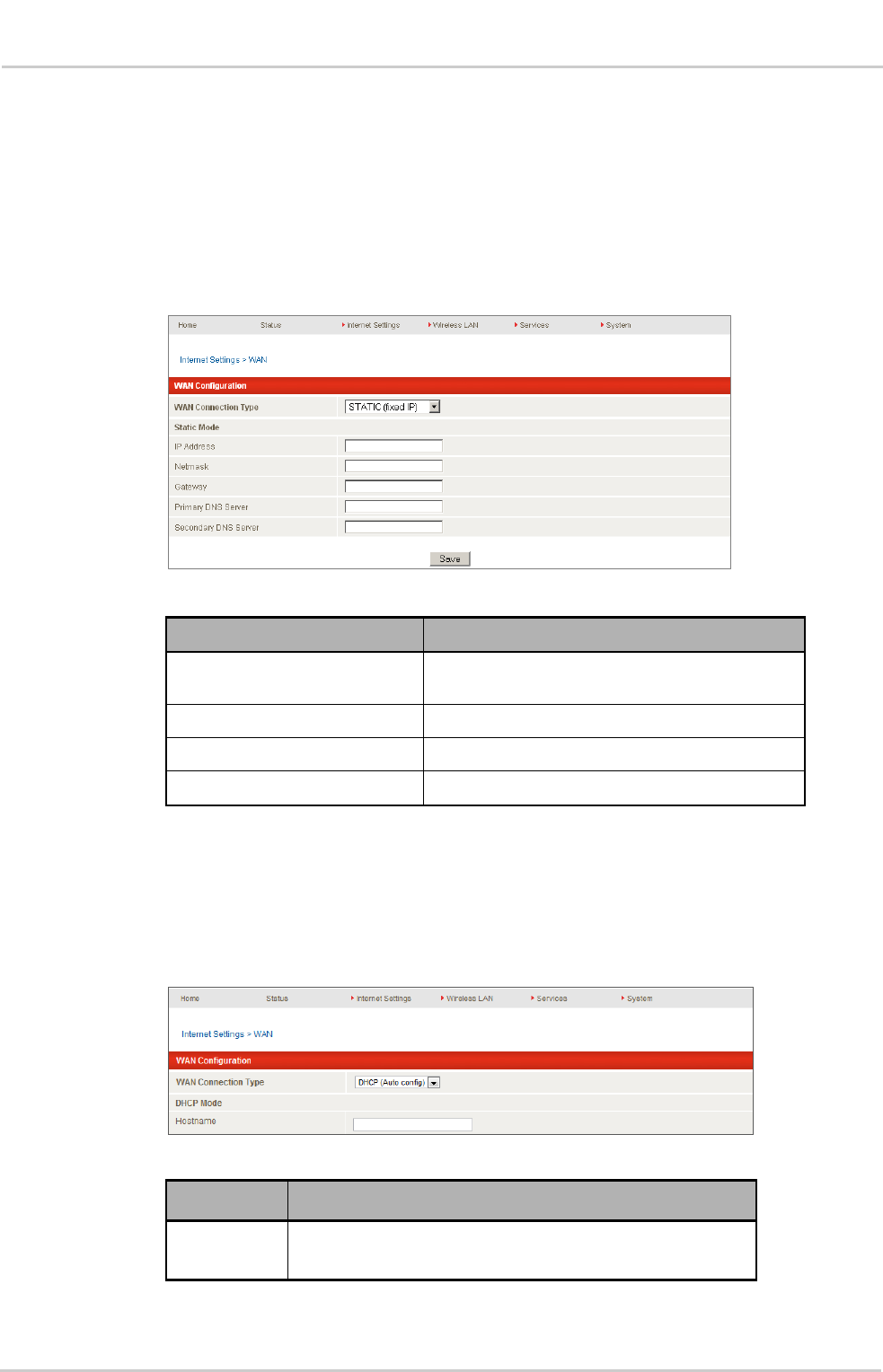
38 2400164
NHD1W User Guide
WAN Configuration
The WAN page allows you to configure the optional WAN Ethernet port. Select the
WAN connection type suitable for your environment and configure parameters
according to the selected connection type.
STATIC (Fixed IP)
If your WAN connection uses a static IP address, please select “STATIC (Fixed IP)”
and fill in the required information in the fields provided.
Figure 16: WAN – STATIC (Fixed IP) Settings
Name
Description
IP Address
Enter the IP address assigned by your Internet
Service Provider (ISP)
Netmask
Enter the Subnet mask assigned by your ISP
Gateway
Enter the WAN Gateway assigned by your ISP
Primary/ Secondary DNS Server
Enter the DNS address assigned by your ISP
Click Save to save the settings.
DHCP
This connection will get the IP address from the Internet service provider. Leave
everything as default unless instructed by your Internet Service Provider.
Figure 17: WAN - DHCP Settings
Field
Description
Hostname
Enter the host name of your computer. This is optional, and
only required if your service provider asks you to do so.
Click Save to apply the settings.
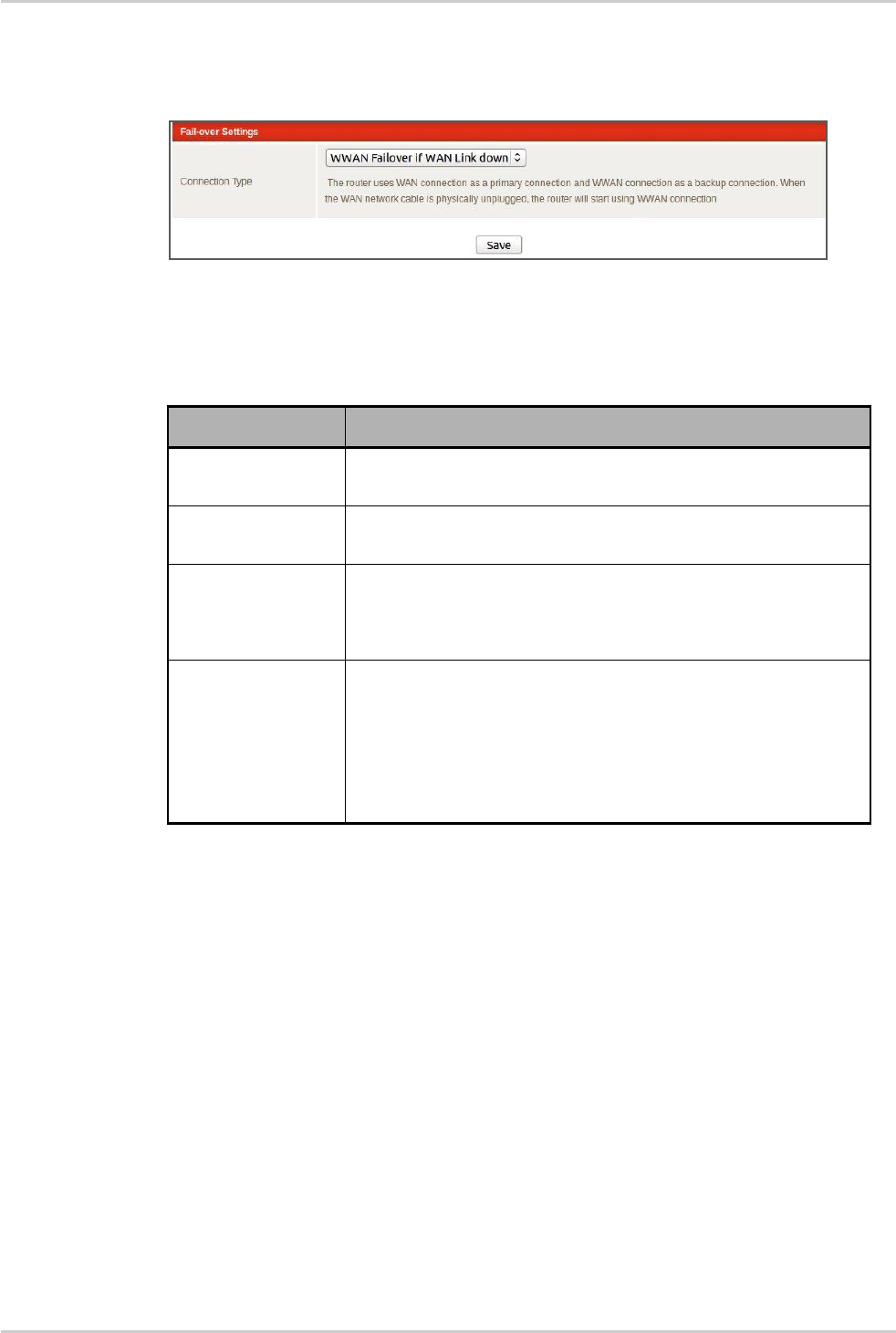
Advanced Settings
Rev 1 Feb. 2012 39
Fail-over Settings
If the LAN1/WAN port is configured in WAN mode, you can select WAN port or
WWAN port to access the Internet connection.
Figure 18: WAN – Fail-over Settings
When both WAN and WWAN connections are available, the NHD1W uses the WAN
connection as the primary connection and the WWAN connection as the backup
connection. In this case you can select one of the four connection types:
Connection Type
Description
WAN
The failover function is disabled and the NHD1W will use WAN
connection only.
WWAN
The NHD1W will use WWAN connection only. AirCard mobile
hotspot will be required for Internet connection.
WWAN Failover if
WAN link down
The NHD1W uses WAN connection as a primary connection and
WWAN connection as a backup connection. When the WAN
connection is physically disconnected, the NHD1W will start using
WWAN connection for Internet access.
WWAN Failover with
WAN ping
The NHD1W uses WAN connection as a primary connection and
WWAN connection as a backup connection. The NHD1W will
periodically ping the assigned servers. When none of the servers
respond to the ping message, the NHD1W will switch to use WWAN
connection for Internet access.
The periodic ping settings can be configured by opening the System
Monitor page under Services menu.
Click Save to apply the settings.
Air Card and Dock(EUT)
EUT supports 2 modes:
1. EUT WLAN function can direct network transmission to other client devices.
2. a. When hotspot router plugged in, EUT WLAN function is disabled. The router
would share the WWAN capability to other client devices, through WLAN
function on the plugged-in router.
b. When the router plugged in, the WWAN RF signal would be directed to
external antenna on EUT, to enhance WWAN receiving capability.
At this moment, the WWAN RF signal would not transmit/receive through
original antenna on the router.
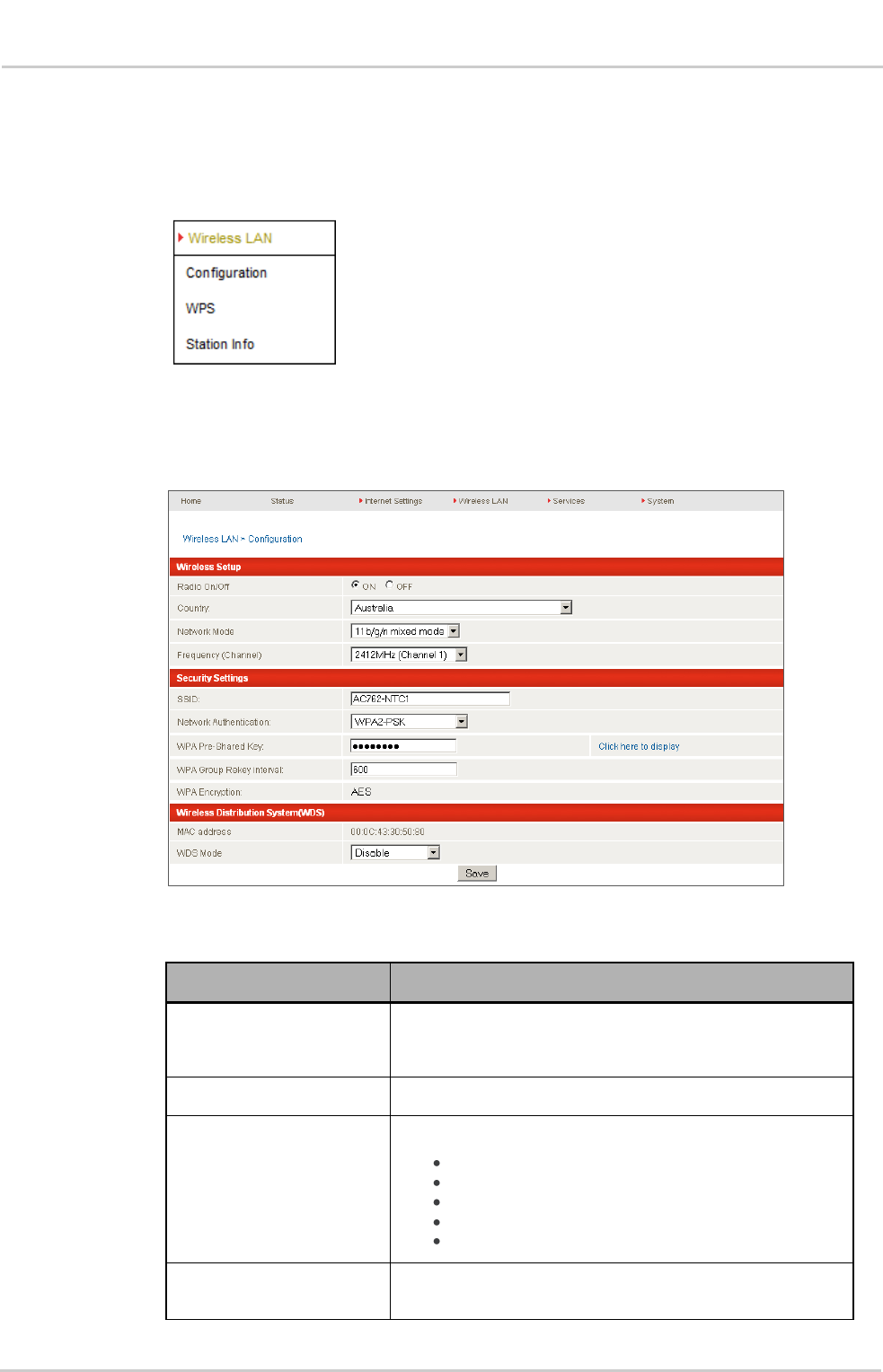
40 2400164
NHD1W User Guide
Wireless LAN (WLAN)
Select Wireless LAN menu to open wireless network configuration pages. You can
open up pages to configure WLAN configuration, to configure WPS setup, or to view
WLAN station information.
Configuration
On this page you can define the wireless settings for the NHD1W.
Figure 19: Advanced View – Wi-Fi Settings
Wireless Setup
Option
Definition
Radio On/Off
Wi-Fi is turned on by default. Changing this option to OFF will
turns OFF the wireless functionality on the NHD1W; you will
not be able to connect to your NHD1W wirelessly.
Country
Select your country.
Network Mode
There are 5 modes to select from:
11b/g mixed mode
11b only
11g only
11n only
11b/g/n mixed mode
Frequency (Channel)
This setting configures the frequency that the wireless radio
uses for wireless connectivity.
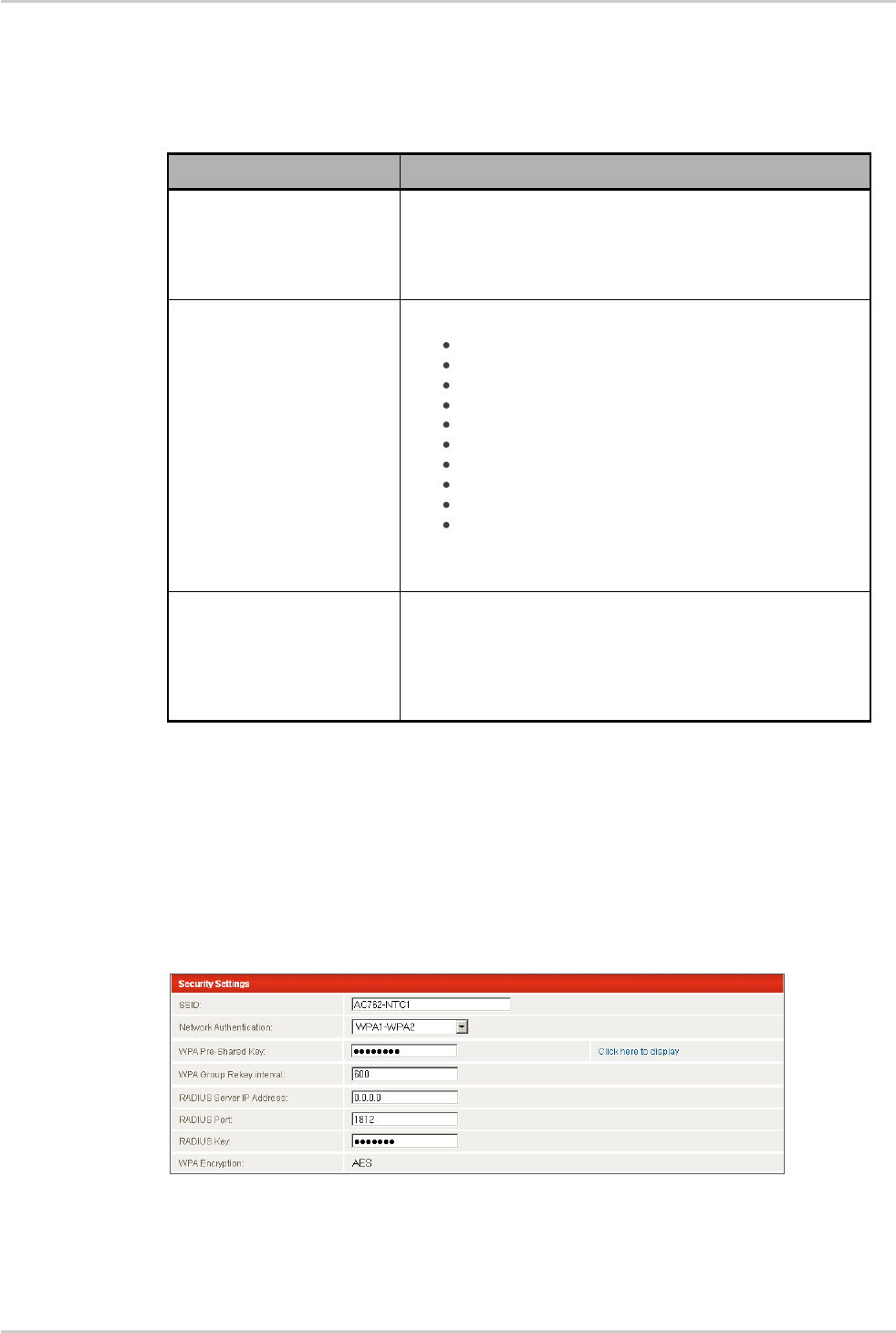
Advanced Settings
Rev 1 Feb. 2012 41
The Security Settings section allows you to configure the wireless security for your
NHD1W. Setting up sufficient wireless security can prevent unauthorized access to
your wireless network.
Security Settings
Option
Definition
Network Name (SSID):
The SSID (Service Set Identifier) is the name of your wireless
network. Use a unique name to identify your wireless device
so that you can easily connect to it from your wireless clients.
This field is case sensitive and can be up to 32 characters.
You should change the default SSID for added security.
Network Authentication
You can choose from the following wireless security options:
Disabled
Open
Shared
WPA
WPA-PSK
WPA2
WPA2- PSK
WPA-PSK-WPA2-PSK
WPA1-WPA2
802.1x.
See the next page for an explanation of the different security
types available.
WDS Mode:
WDS (Wireless Distribution System) is a feature that enables
the wireless interconnection of access points, and allows a
wireless network to be expanded using multiple access points
without a wired backbone to link them. Each WDS Access
Point needs to be set with the same channel and encryption
type.
Network Authentication Options
WPA1/WPA2
WPA (Wi-Fi Protected Access) authentication is suitable for enterprise applications. It
must be used in conjunction with an authentication server, such as RADIUS, to
provide centralized access control and management. It provides a stronger
encryption and authentication solution.
Figure 20: Wi-Fi Security Settings - WPA1/WPA2
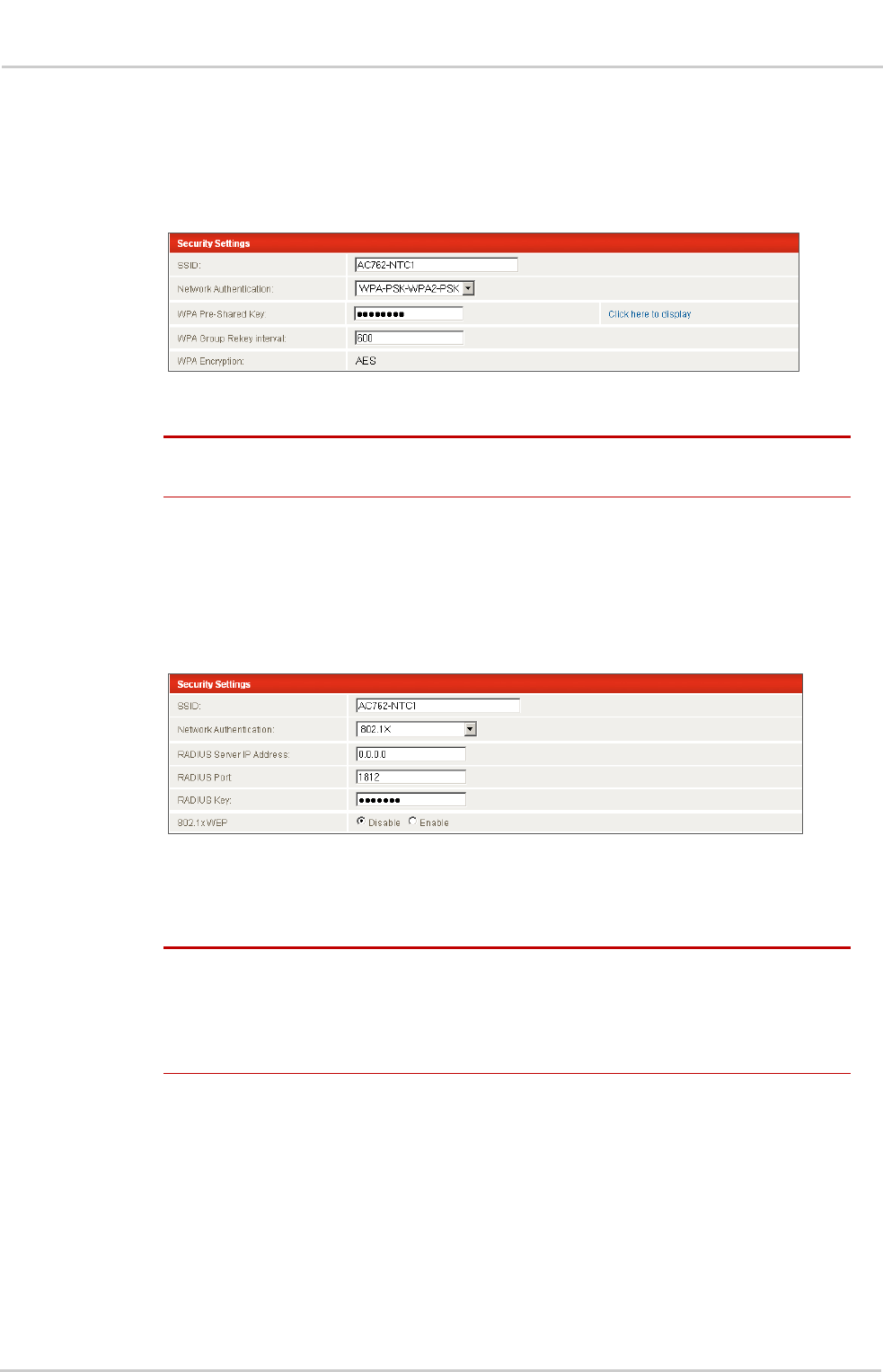
42 2400164
NHD1W User Guide
WPA-PSK/WPA2-PSK
WPA-PSK (TKIP) and WPA2-PSK (AES) are newer types of security. These types of
security give a more secure network compared to WEP. Enter the key in the WPA
Pre-Shared Key field. The key needs to be more than 8 characters and less than 63
characters and it can be any combination of letters and numbers.
Figure 21: Wi-Fi Security Settings - WPA-PSK/WPA2-PSK
Note: The configuration for WPA-PSK and WPA2-PSK is also identical. Your NHD1W uses
WPA2-PSK by default.
802.1x
To use 802.1x security, you need to have a RADIUS server on your network that acts
as the authentication server. Please type in the details for your RADIUS server in the
fields required.
Figure 22: Wi-Fi Security Settings - 802.1x
Most wireless adapters in computers and laptops support at least WEP and WPA.
Note: After configuring wireless security, you also need to configure your wireless adapter to
use the same security settings before you can connect wirelessly. Not all wireless adapters
support WPA-PSK/WPA2-PSK/WPA/WPA2 security; please refer to your wireless adapter user
guide for more details. It is strongly recommended to set up a simple wireless security such as
WPA-PSK (when the wireless client supports WPA-PSK) in order to secure your network.
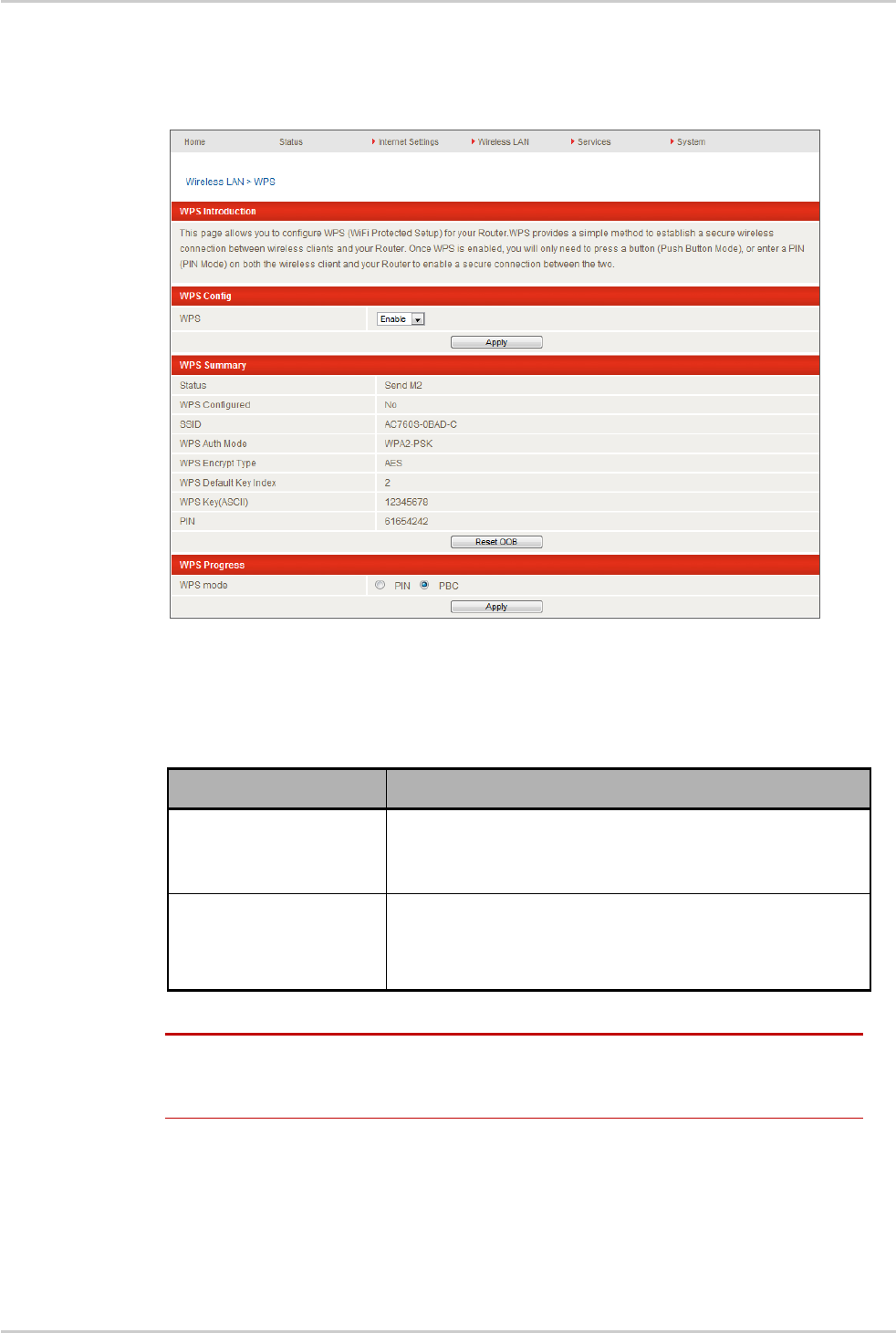
Advanced Settings
Rev 1 Feb. 2012 43
Wi-Fi Protected Setup (WPS)
The NHD1W supports the WPS feature that allows users with suitable devices to
quickly connect to a Wi-Fi network without the use of a keyboard.
Figure 23: Wi-Fi Protected Setup (WPS)
If the WPS is enabled by selecting Enable, then WPS Summary and WPS Progress
sections are displayed, as shown in Figure 23 above. You can select either PIN mode
or PBC mode.
WPS mode
Definition
PIN
When this mode is selected, you need to enter a PIN on both
the wireless client and your NHD1W to enable a secure
wireless connection. For instructions on displaying the PIN, see
the user manual of your wireless device.
PBC
When the PBC (Push Button Configuration) mode is enabled
you need to press the WPS button on the AirCard mobile
hotspot to initiate the process to enable a secure wireless
connection.
Note: The WPS feature is available on many more recent products, such as cameras, printers,
smart phones, and laptops. Check the user guide that came with your device to find out if this
feature is supported and to configure your device.
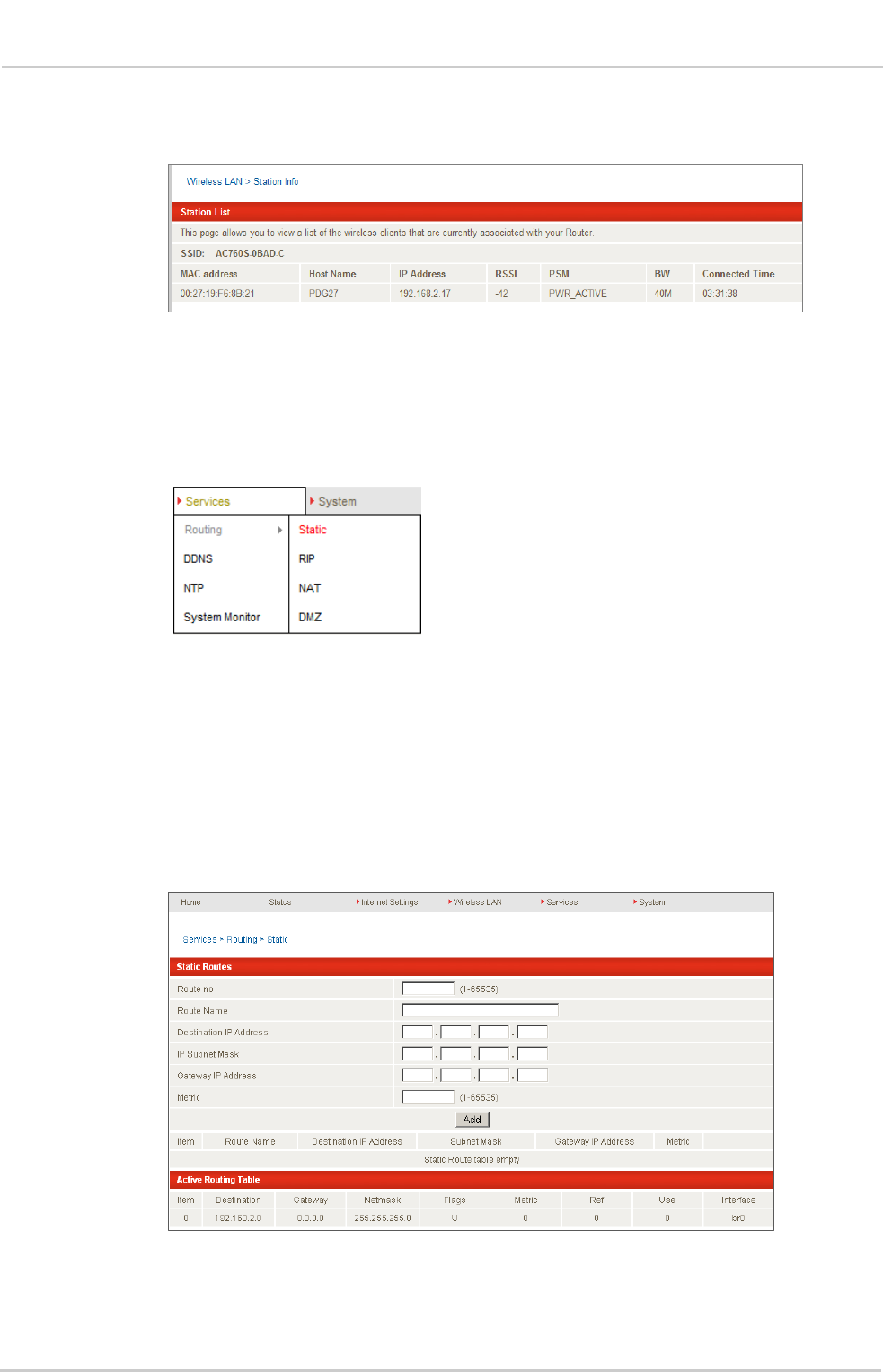
44 2400164
NHD1W User Guide
Station Info
The Station List shows the wireless clients currently associated with your NHD1W.
Figure 24: Advanced View - Wi-Fi Station List
Services
Select the Services menu to configure Routing, DDNS, NTP and System Monitor
settings.
Routing
From this menu, you can open the Static Routes, RIP Routing, NAT settings, or DMZ
settings page.
Static
The Static Routes page is used to add or delete static routes. Static routes are used
to facilitate communication between devices on different networks.
Figure 25: Static Route Settings
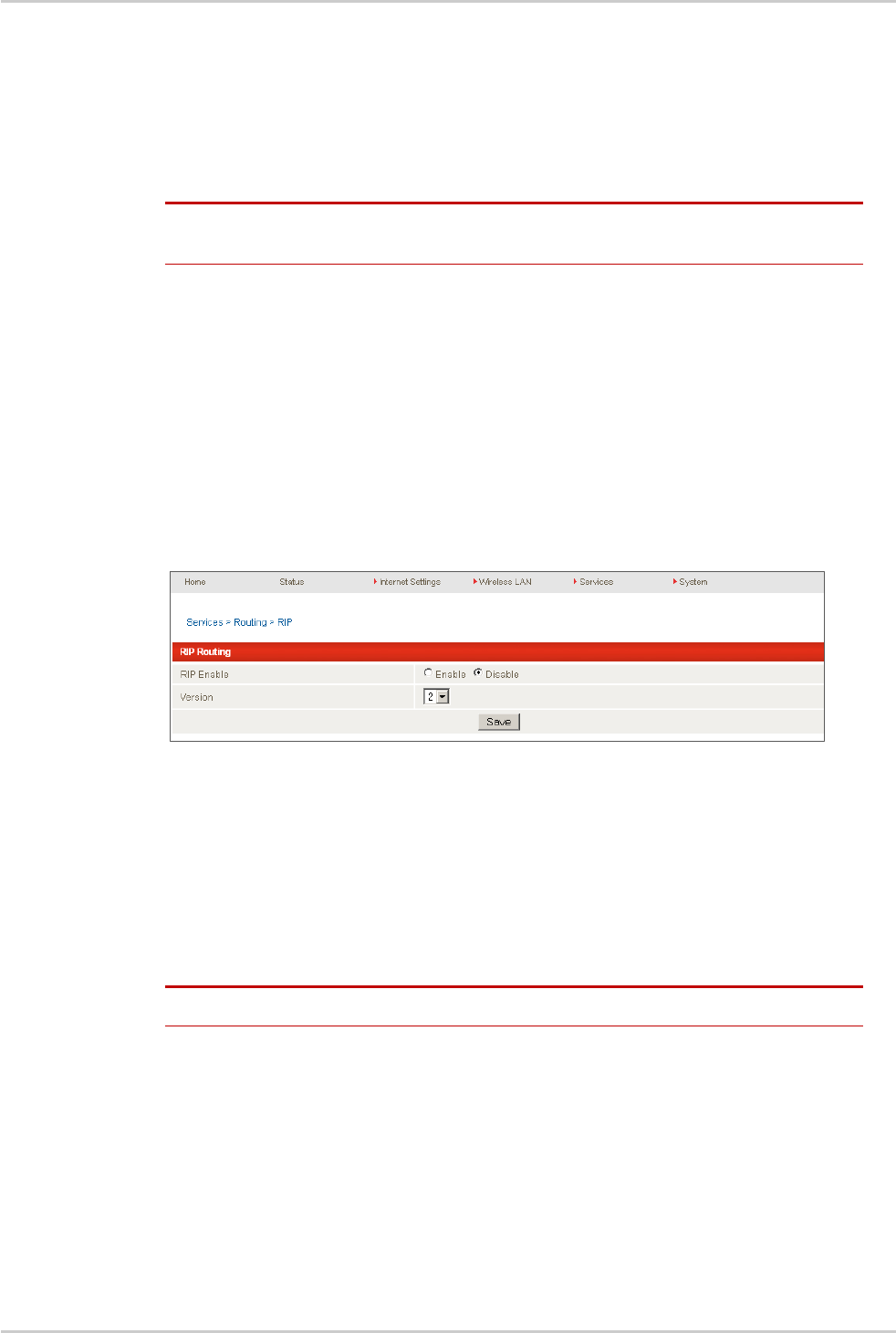
Advanced Settings
Rev 1 Feb. 2012 45
Some routes are added by default by the NHD1W on initialization such as the
Ethernet subnet route for routing to a device on the Ethernet subnet. A PPP route is
also added upon obtaining a WAN PPP connection.
To add static routes:
1. Enter the required values in the fields for the route being added.
2. Click Add.
Note: You must increment the “Route no” by 1 for each route in the “Route no” field;
otherwise that route will be overwritten.
The Active Routing table at the bottom will then show the new route added.
To delete Static Routes, click the “Delete Entry” text (in blue).
RIP
RIP (Routing Information Protocol) is used for advertising routes to other routers.
Thus, all the routes in the NHD1W’s routing table are advertised to other nearby
routers. For example, the route for the NHD1W’s Ethernet subnet could be advertised
to a router on the PPP interface side, so that a router on this network will know how to
route to a device on the NHD1W’s Ethernet subnet. You will need to add the routes
appropriately in the Static Routes section on page 44.
Figure 26: RIP Settings
To configure RIP Settings:
1. Select Enable on the RIP Page.
2. Select RIP version.
3. Click Save.
Note: Some routers ignore RIP.
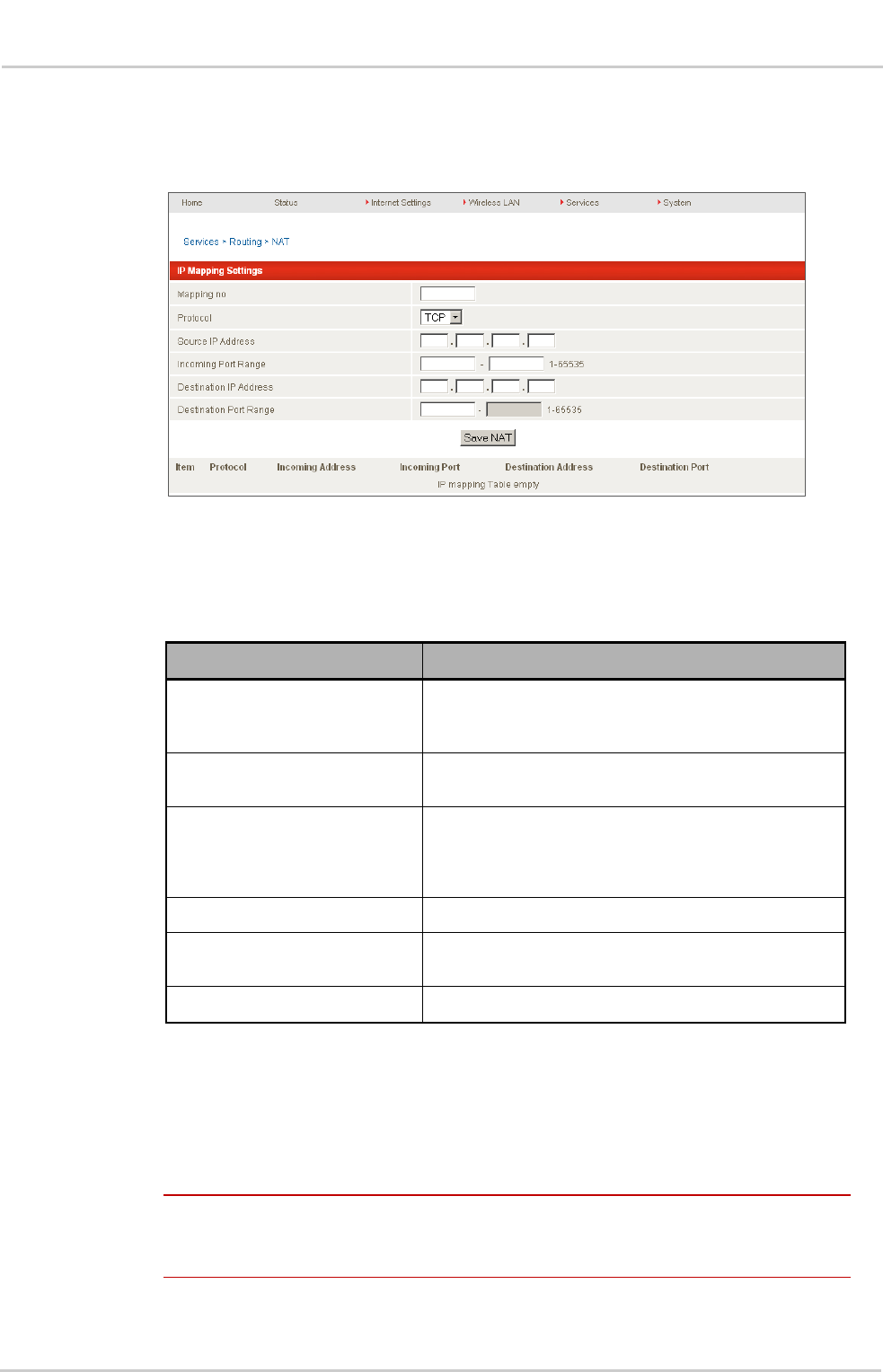
46 2400164
NHD1W User Guide
NAT
The NAT page is used to configure the Network Address Translation rules currently in
use on the NHD1W. The NHD1W is in NAT mode by default.
Figure 27: NAT Settings
This is only needed if you need to map inbound requests to a specific port on the
WAN IP address to a device connected on the Ethernet interface, for example, a web
camera.
Option
Definition
Mapping no
For each mapping you’re defining, enter a unique
number, and then enter the details in the following
fields.
Protocol
Specify the protocol to use for the port mapping (TCP,
UDP, All protocols).
Source IP Address
Specifies either a “Friendly” IP address that is allowed
to access the NHD1W, or a wildcard IP address of
0.0.0.0 that allows all IP addresses to access the
NHD1W.
Incoming Port Range
Specify the external port(s) to listen to.
Destination IP Address
Local Area Network address of the device to forward
inbound requests to.
Destination Port Range
Local Area Network port(s) to forward connections to.
To configure Port Forwarding:
1. Enter the IP Mapping configuration information as appropriate.
2. Click Save NAT.
Note: If the “Incoming Port Range” specifies a single port, then the destination port can be
set to any port. If the “Incoming Port Range” specifies a range of port numbers then the
“Destination Port Range” MUST be the same as the “Incoming Port Range”.
To delete a port forwarding rule, click the corresponding “Delete Entry” link from the
list of IP Mappings.
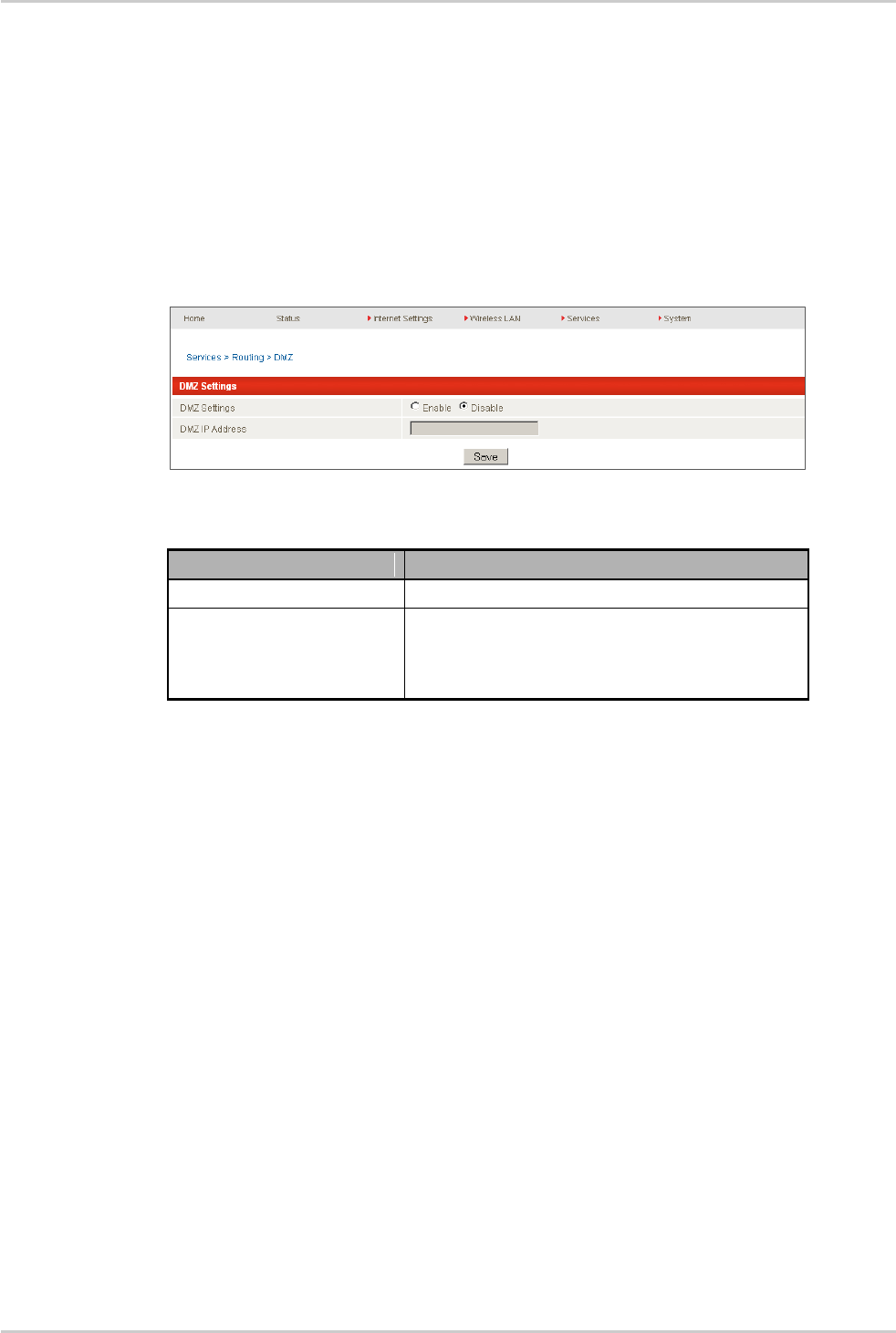
Advanced Settings
Rev 1 Feb. 2012 47
DMZ
If you have a client PC that cannot run an Internet application (for example, games)
properly from behind the NAT firewall, then you can open up the firewall restrictions
to allow unrestricted two-way Internet access by defining a DMZ Host.
The DMZ function allows you to re-direct all packets going to your WAN port IP
address, to a particular IP address in your LAN. The difference between the virtual
server and the DMZ function is that the virtual server re-directs a particular
service/Internet application (for example FTP, websites) to a particular LAN
client/server, whereas DMZ re-directs all packets (regardless of services) going to
your WAN IP address to a particular LAN client/server.
Figure 28: Advanced View - DMZ Settings
Option
Definition
DMZ Settings:
Enable/disable DMZ.
DMZ IP Address:
Fill in the IP address of a particular host in your
LAN network that will receive all the packets
originally going to the WAN port/Public IP
address of your NHD1W.
To configure DMZ Settings:
1. For DMZ Settings, click Enable.
2. Enter DMZ IP Address.
3. Click Save.
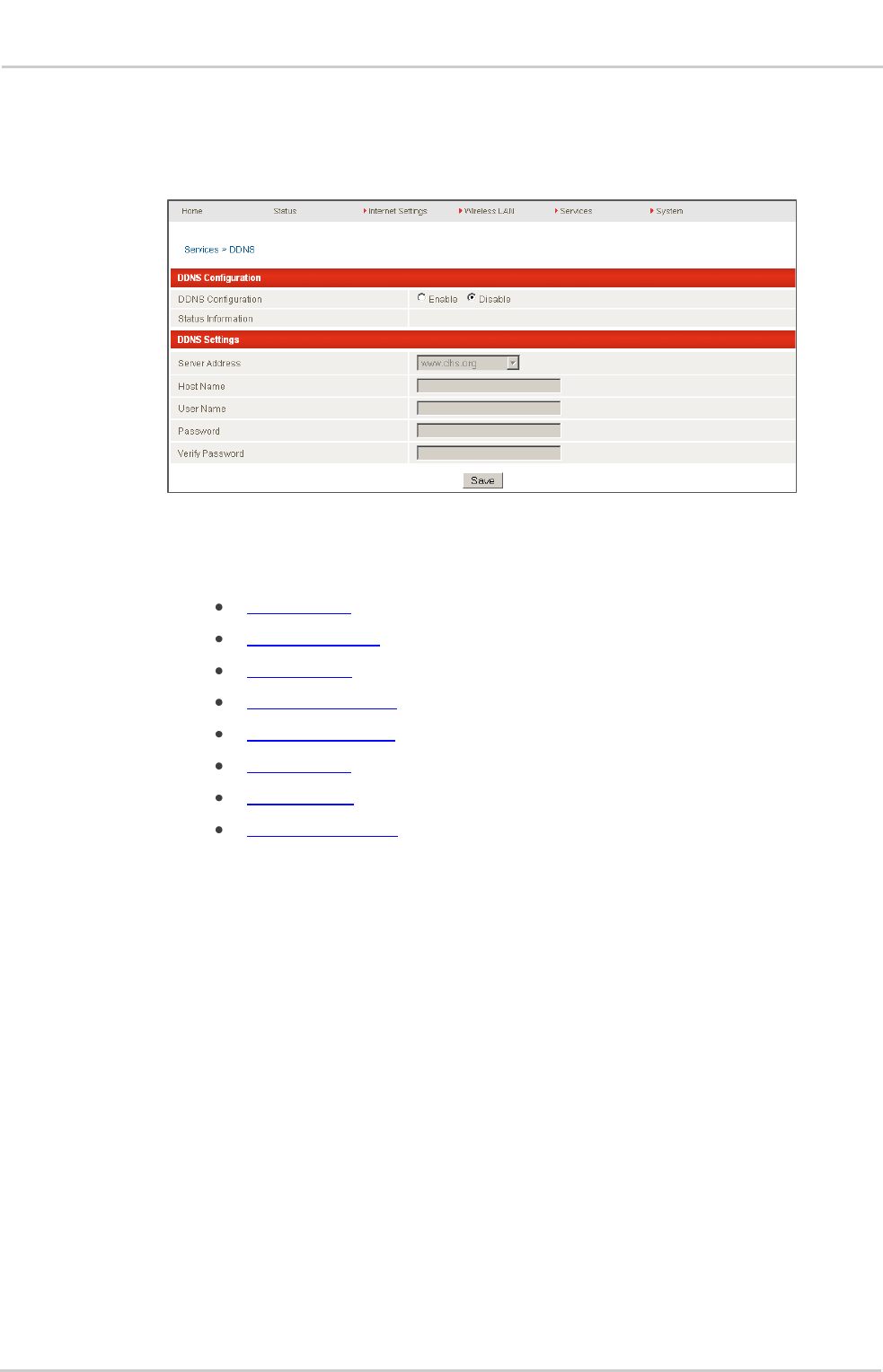
48 2400164
NHD1W User Guide
DDNS
The DDNS page is used to configure the Dynamic DNS feature of the NHD1W. You
can select from a number of dynamic DNS hosts.
Figure 29: DDNS Settings
Dynamic DNS provides a method for the NHD1W to update an external name server
with the current WAN IP address. The following DDNS Providers are available:
www.dhs.org
www.dyndsn.org
www.dyns.cx
www.easydns.com
www.justlinux.com
www.ods.org
www.tzo.com
www.zoneedit.com
To configure dynamic DNS:
1. Select DDNS Configuration Enable.
2. Select the Dynamic DNS service that you wish to use. Enter your dynamic DNS
account credentials.
3. Click Save.
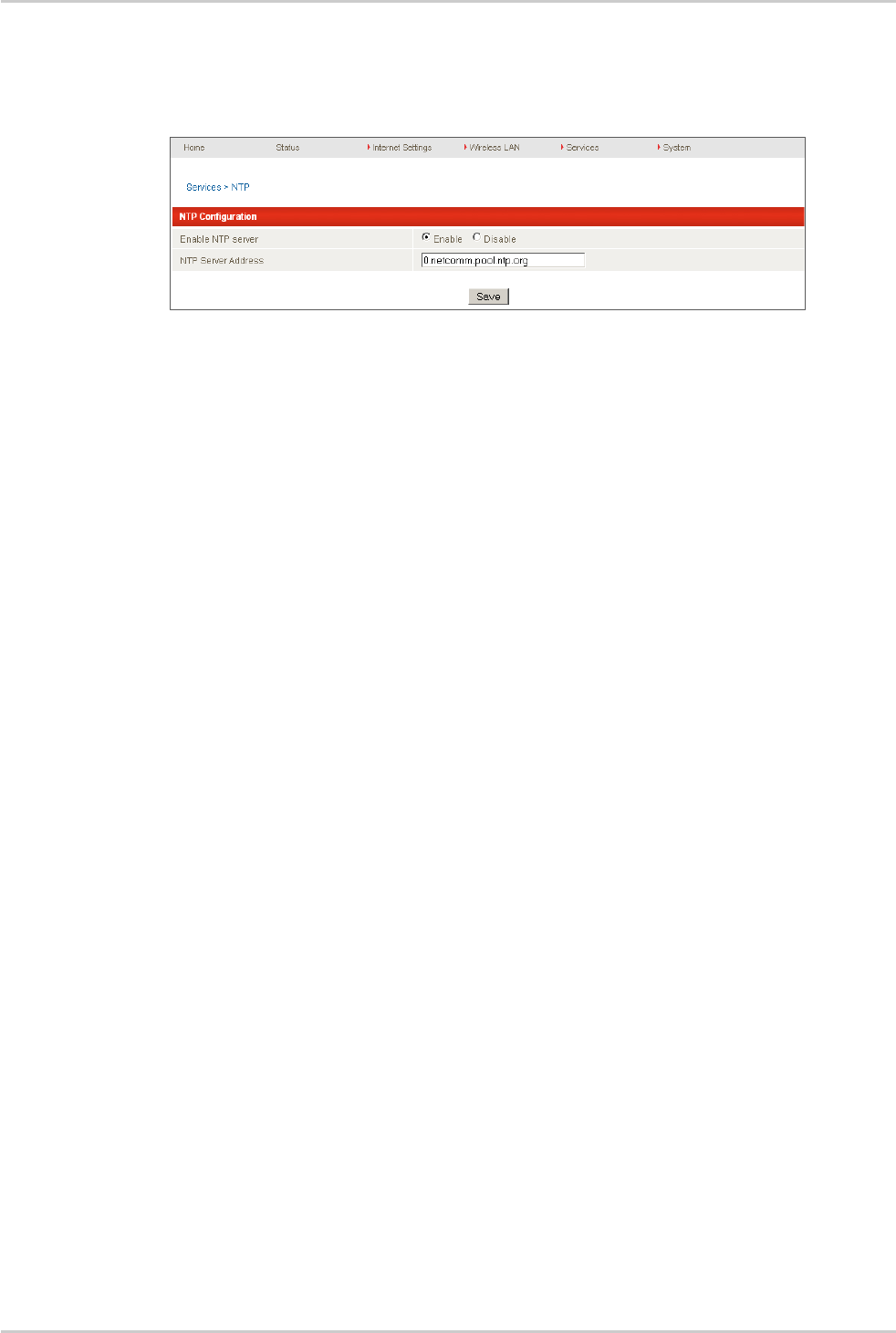
Advanced Settings
Rev 1 Feb. 2012 49
NTP
The NTP page is used to select the NTP server used for network time
synchronization.
Figure 30: NTP Settings
The NTP (Network Time Protocol) settings allow your NHD1W to synchronize its
internal clock with a global Internet Time server. This setting affects functions such as
System Log entries and Firewall settings, where the current system time is displayed.
You can use the default NTP server or enter one manually if required.
To configure NTP Settings:
1. Select Enable for Enable NTP server.
2. Enter NTP Server Address.
3. Click Save.
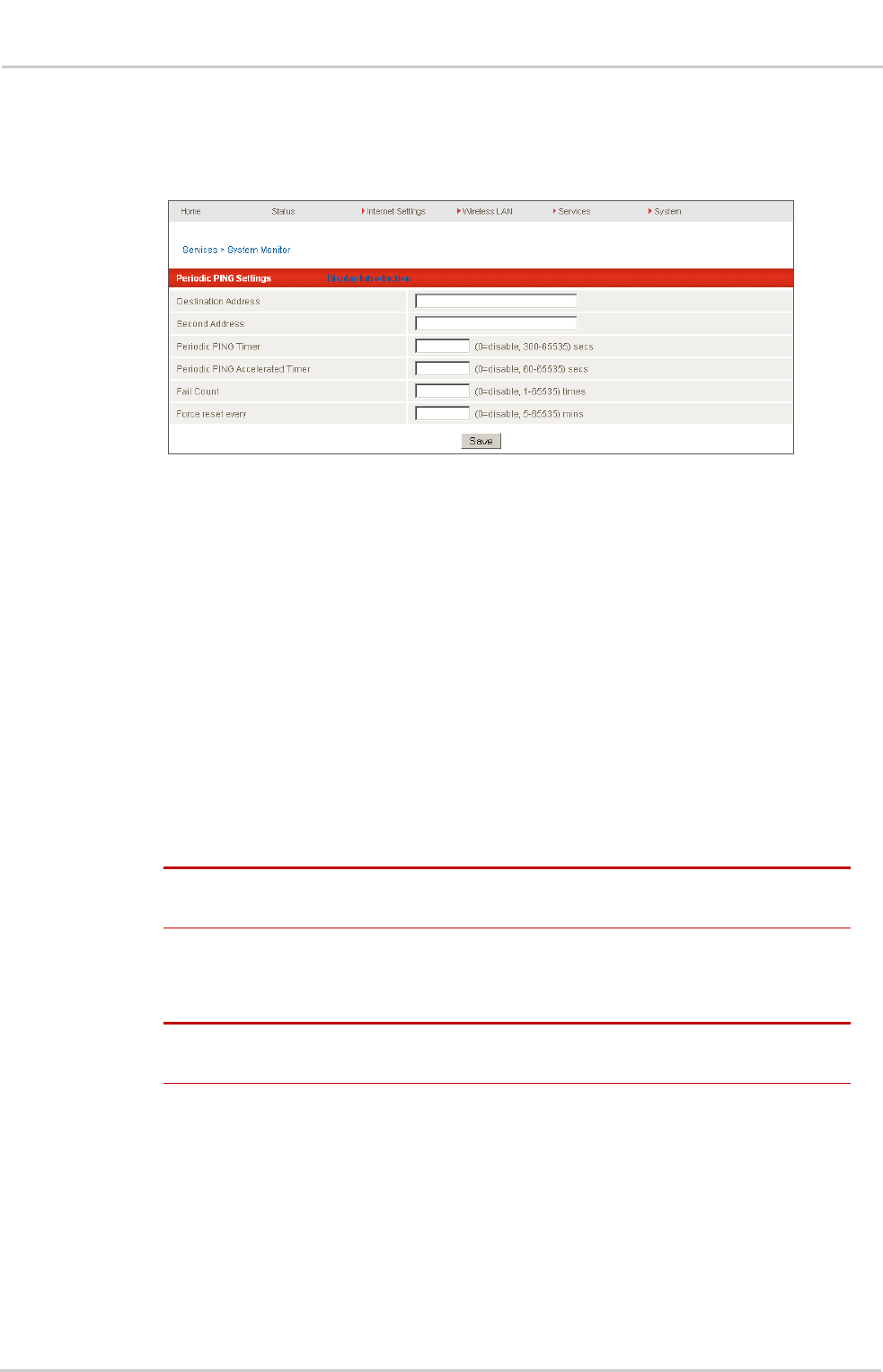
50 2400164
NHD1W User Guide
System Monitor
The System Monitor page is used to configure the behaviour of the Periodic Ping
monitor function.
Figure 31: System Monitor Settings
The Periodic Ping Reset Monitor configures the NHD1W to transmit controlled ping
packets to 2 specified IP addresses. If the NHD1W does not receive responses to the
pings, the NHD1W reboots.
This works as follows:
1. After every “Periodic PING Timer” configured interval, the NHD1W sends 3
consecutive pings to the “Destination Address”.
2. If all 3 pings fail, the NHD1W sends 3 consecutive pings to the “Second
Address”.
3. The NHD1W then sends 3 consecutive pings to the “Destination Address” and 3
consecutive pings to the “Second Address” every “Periodic PING Accelerated
Timer” configured interval.
4. If all accelerated pings in step 3 above fail, the number of times configured in
“Fail Count”, the NHD1W reboots.
Note: Do not set the “Periodic PING Timer” to a value less than 60 seconds; this is to allow the
NHD1W time to reconnect to the 3G/4G network following a reboot.
5. If any ping succeeds, the NHD1W returns to step 1 and does not reboot.
To disable the Periodic Ping Reset Monitor set “Fail Count” to 0.
Note: The traffic generated by the periodic ping feature is counted as chargeable usage;
please keep this in mind when selecting how often to ping.
Configure a Forced Reset
The NHD1W can optionally be configured to automatically reboot after a period of
time specified in minutes. This ensures that the NHD1W will restart if some anomaly
occurs. This is useful in remote installations.
This feature is available by clicking Services > System Monitor.
The default value is 0, which disables the Forced Reset Timer. The maximum value is
65535 minutes.
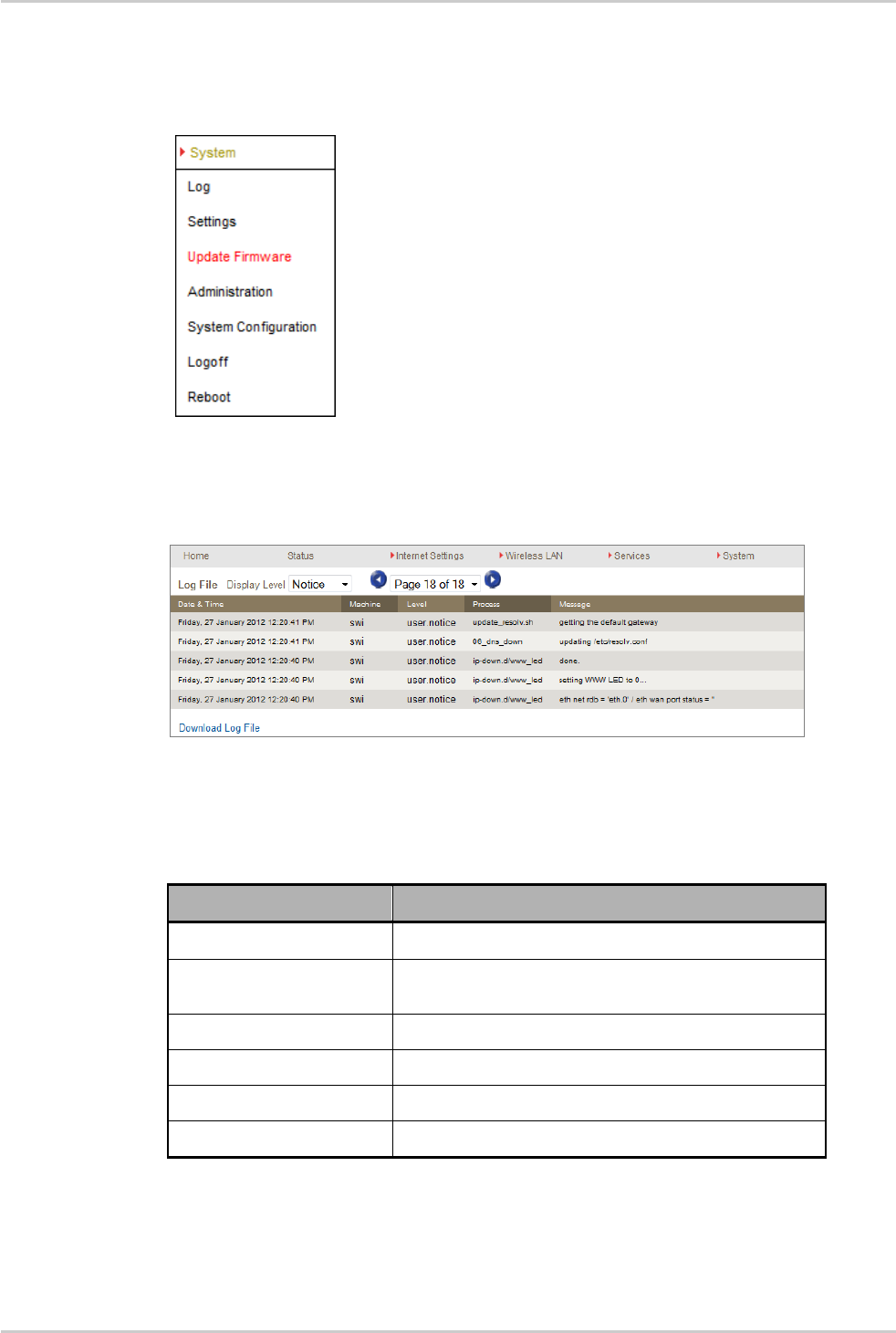
Advanced Settings
Rev 1 Feb. 2012 51
System
Select the System menu to view system information or to configure system level
settings.
Log
The Log page is used to download or display the current System Log of the NHD1W.
Figure 32: System Log
The System Log enables you to troubleshoot any issues you may be experiencing
with your NHD1W. You can specify the level of detail (types of messages) to display,
as shown in the following table.
Display Level
Definition
All
Display all system log messages.
Debug
Show extended system log messages with full
debugging level details.
Info
Show informational messages only.
Notice
Show normal system logging information.
Warning
Show warning messages only.
Error
Show error condition messages only.
You can also download the current System Log to your computer for off-line viewing.
To do this, click the Download Log File link at the bottom of the page.
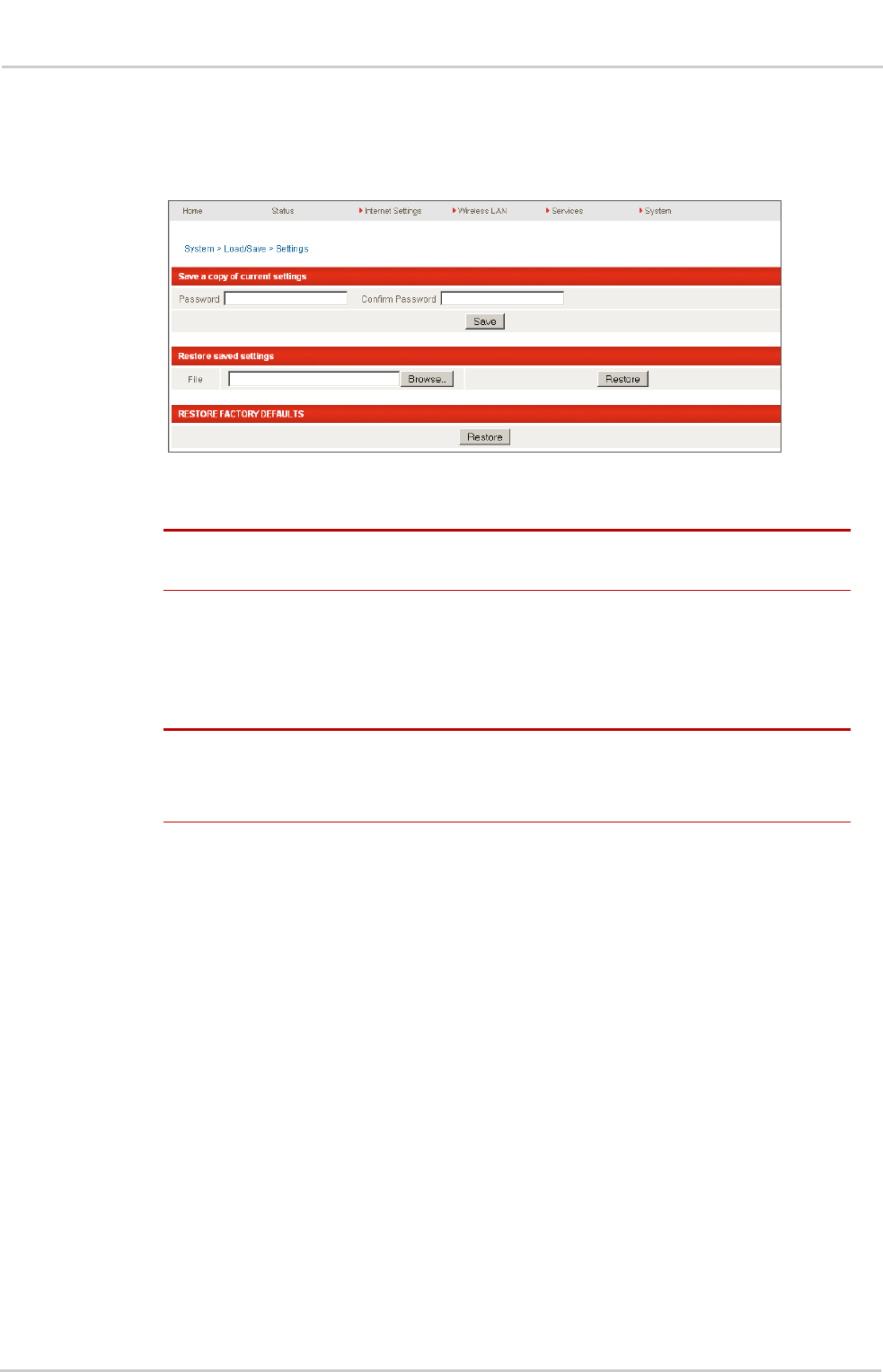
52 2400164
NHD1W User Guide
Settings
The settings page is used to back up or restore the NHD1W’s configuration or to
reset it to factory defaults.
Figure 33: Load / Save Configuration Page
Note: To perform an update, you must be logged into the NHD1W as the root user (see the
Administration section on page 54 for more details).
To save a copy of the NHD1Ws configuration:
1. Enter the root manager Password and click Save.
This will download a copy of the NHD1W’s current settings to your PC.
Note: Do NOT edit the contents of the file downloaded file; if you modify it, you might not be
able to use it to restore the NHD1W’s configuration later.
You can change the name of the file but the filename extension must remain “.cfg”.
To restore the NHD1W’s configuration using downloaded file:
1. Click Browse.
2. Select the configuration file you wish to restore.
3. Click Restore under Restore saved settings.
To restore the NHD1W’s configuration to the factory defaults:
1. Click Restore under RESTORE FACTORY DEFAULTS.
The NHD1W will then restart.
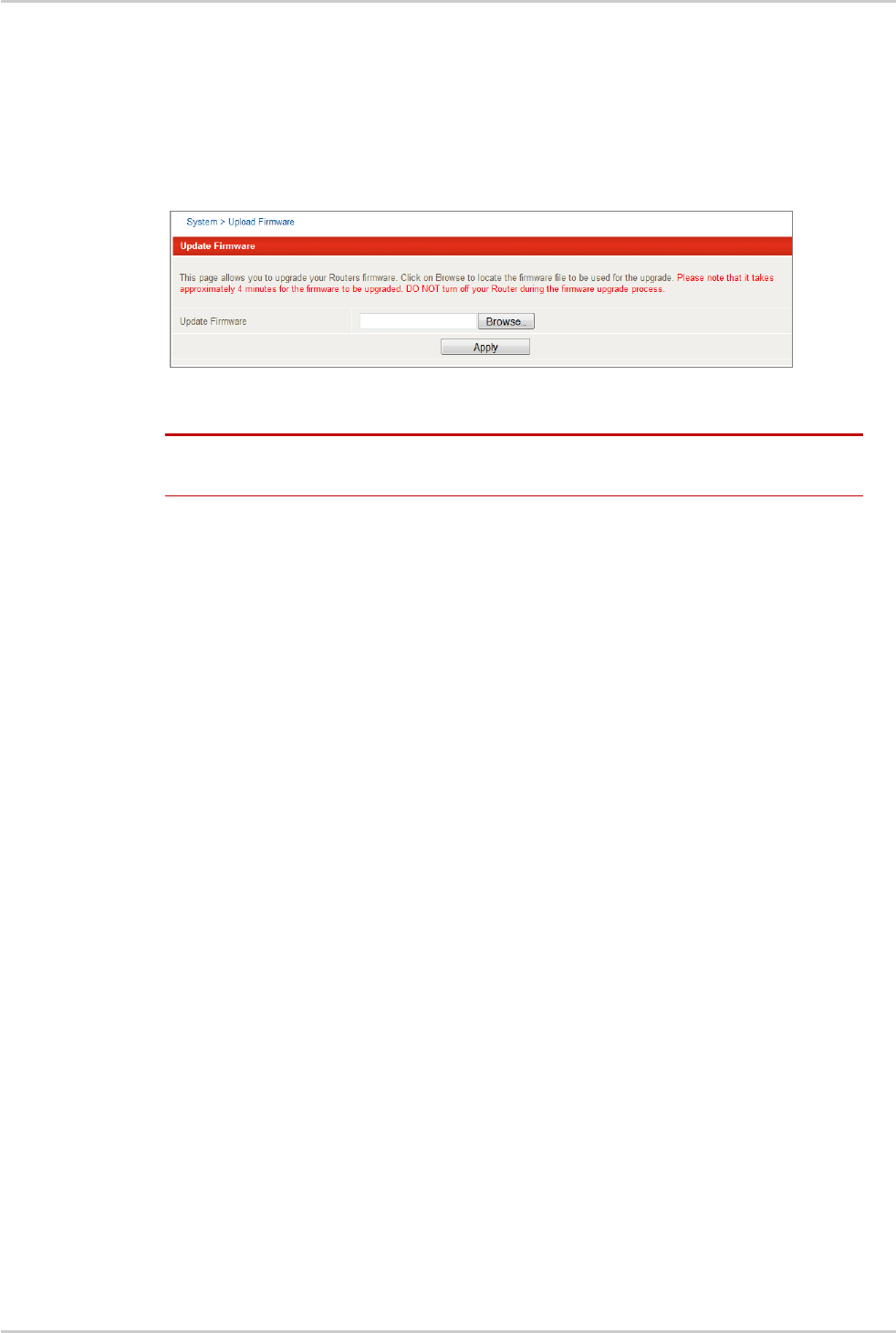
Advanced Settings
Rev 1 Feb. 2012 53
Update Firmware
This page allows you to upgrade the NHD1W’s internal software (firmware).
The upgrade process takes approximately 4 minutes. During the firmware upgrade
process, all the lights on the front of the NHD1W will flash.
Figure 34: Advanced View - Firmware Update
Warning: Do NOT turn off the NHD1W during the firmware upgrade process. It is
recommended to use Ethernet LAN interface for firmware upgrades.
To upgrade the firmware of your NHD1W:
1. Download the upgrade image file from the NetComm Wireless support site
www.netcomm.com.au.
2. Click the Browse button and navigate to the location of the firmware file that
you've downloaded.
3. Click Apply to start the upgrade process.
4. Follow the on-screen prompts.
Once completed, your NHD1W will reboot to the Easy mode operation.
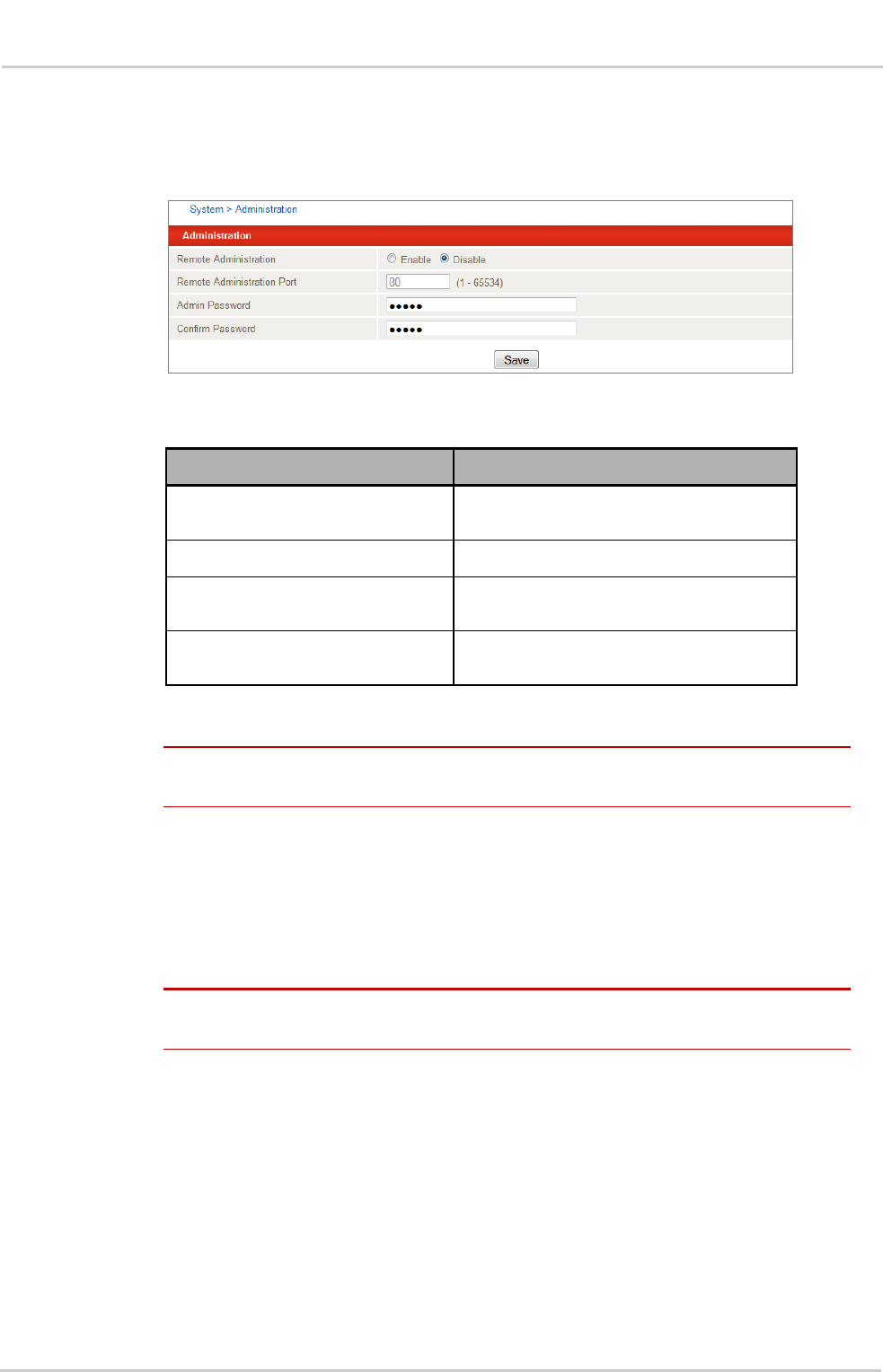
54 2400164
NHD1W User Guide
Administration
The Administration page is used to enable or disable remote administration and set
the username / password required to access the NHD1W remotely.
Figure 35: Administration Configuration Items
Option
Definition
Remote Administration
Enable or disable remote HTTP access to
the NHD1W.
Remote Administration Port
Set the port to use for remote HTTP access.
Admin Password
Enter the new password for the selected
user account.
Confirm Password
Re-enter the new password for the selected
user account.
Note: It is not necessary to change the password if you are only changing the incoming port
number.
To access the NHD1W’s configuration pages remotely:
1. Open a browser window (for example Internet Explorer, Firefox, Safari).
2. In the address bar, enter the NHD1W’s WAN IP address and assigned port
number, for example “10.10.10.10: 8080”.
Note: You can find the NHD1W’s WAN IP address by clicking the “Status” menu. The Local
field in the WWAN section shows the NHD1W’s WAN IP address.
3. Click Login and type “admin” in the Username and “admin” in the Password
fields (without quotes). Then click on Submit.
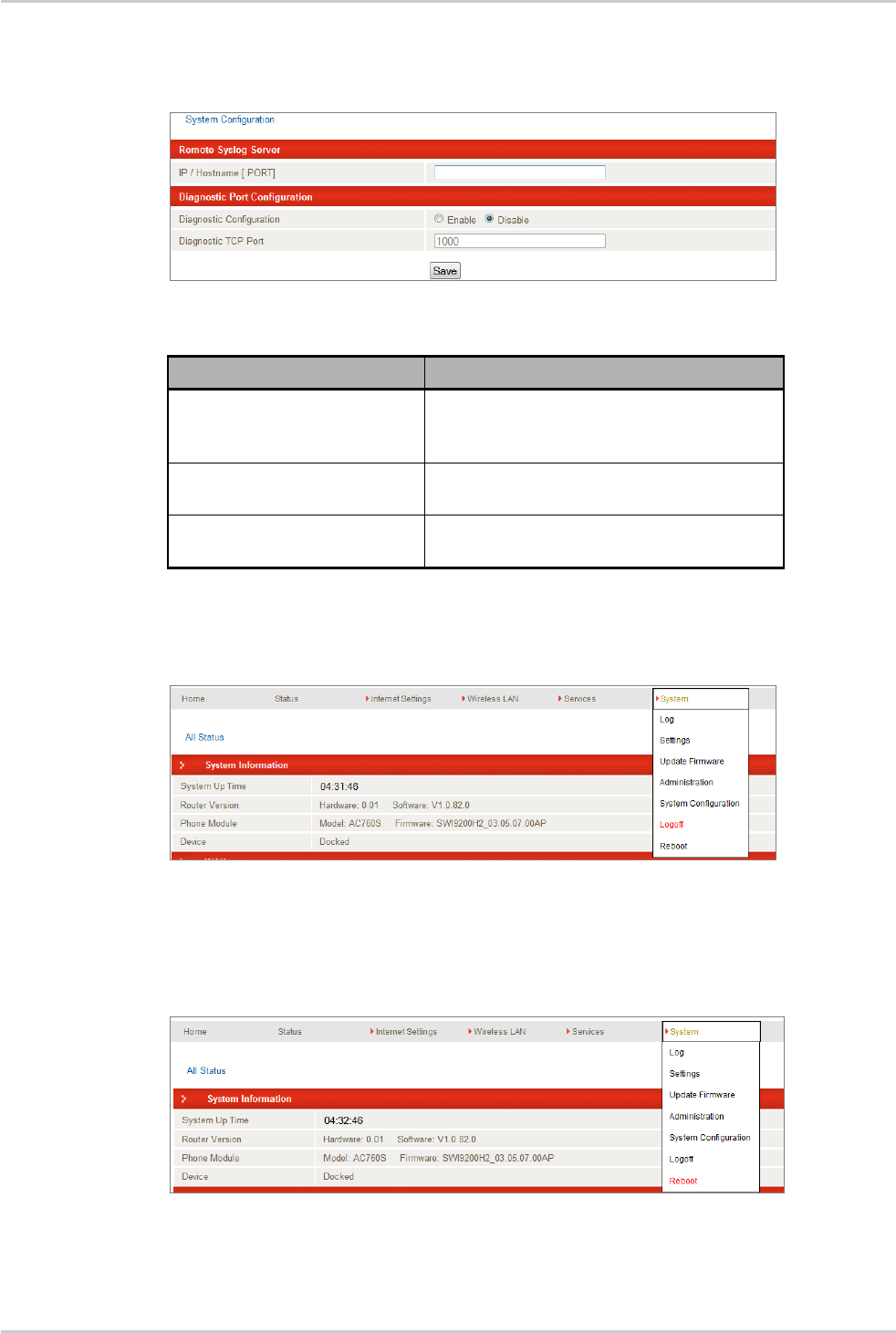
Advanced Settings
Rev 1 Feb. 2012 55
System Configuration
The System Configuration page is used to specify an external syslog server or enable
the diagnostics function.
Figure 36: System Configuration Items
Option
Definition
IP / Hostname [:PORT]
The IP address and port of the external
syslog server that the logging information
will be sent to.
Diagnostic Configuration
Enable or disable the diagnostics function
on the NHD1W.
Diagnostic TCP Port
The port that the diagnostic server
software is listening on.
Logoff
The logoff item logs you out of your web configuration session.
Figure 37: Logoff
Reboot
The reboot item reboots the NHD1W. This can be useful if you have made
configuration changes you want to implement or want to reboot the NHD1W.
Figure 38: Reboot NHD1W

56 2400164
NHD1W User Guide
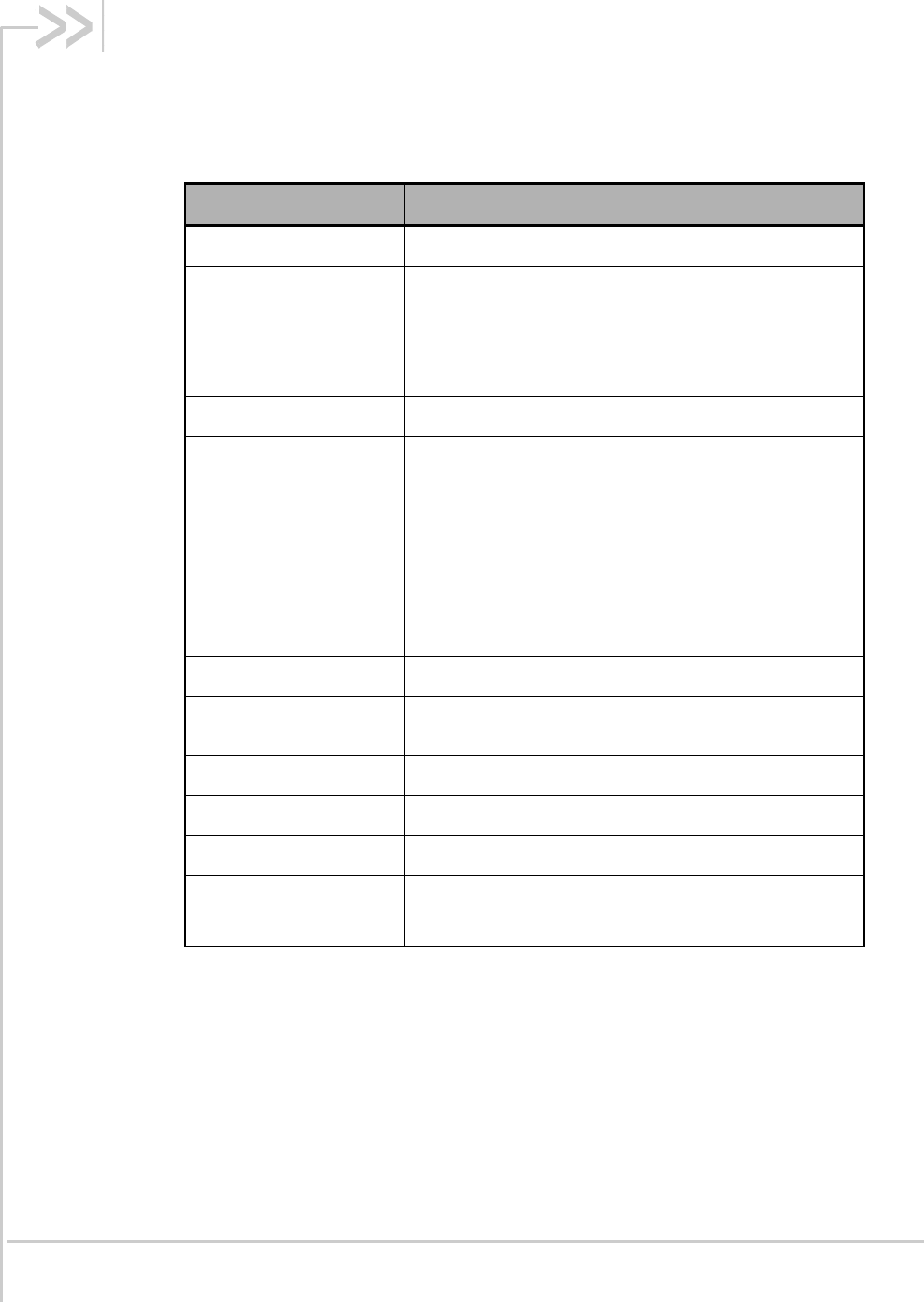
Rev 1 Feb. 2012 57
5: Specifications
Technical Specifications
Model
Description
CPU
Ralink RT3352F
Connectivity
3x 10/100 Ethernet LAN,
1x 10/100 Ethernet LAN/WAN,
WLAN (up to 16 connections)
2x USB ports
Antenna connector
2 x SMA (female connector)
LED indicators
Power
WLAN
WWAN,
LAN1/WAN
LAN2
LAN3
LAN4
Operating temperature
0 ~ 50 degrees Celsius
Ambient temperature
(Power Supply Unit)
0 ~ 35 degrees Celsius
Storage temperature
-20 to 65 degrees Celsius
Power input
12VDC – 2A
Wi-Fi antennas
802.11 b/g/n - 2.4 GHz, 2x2 MIMO internal antennas
3G/4G antennas
Multi band dipole
698‐960/1710‐2170/2500‐2700MHz
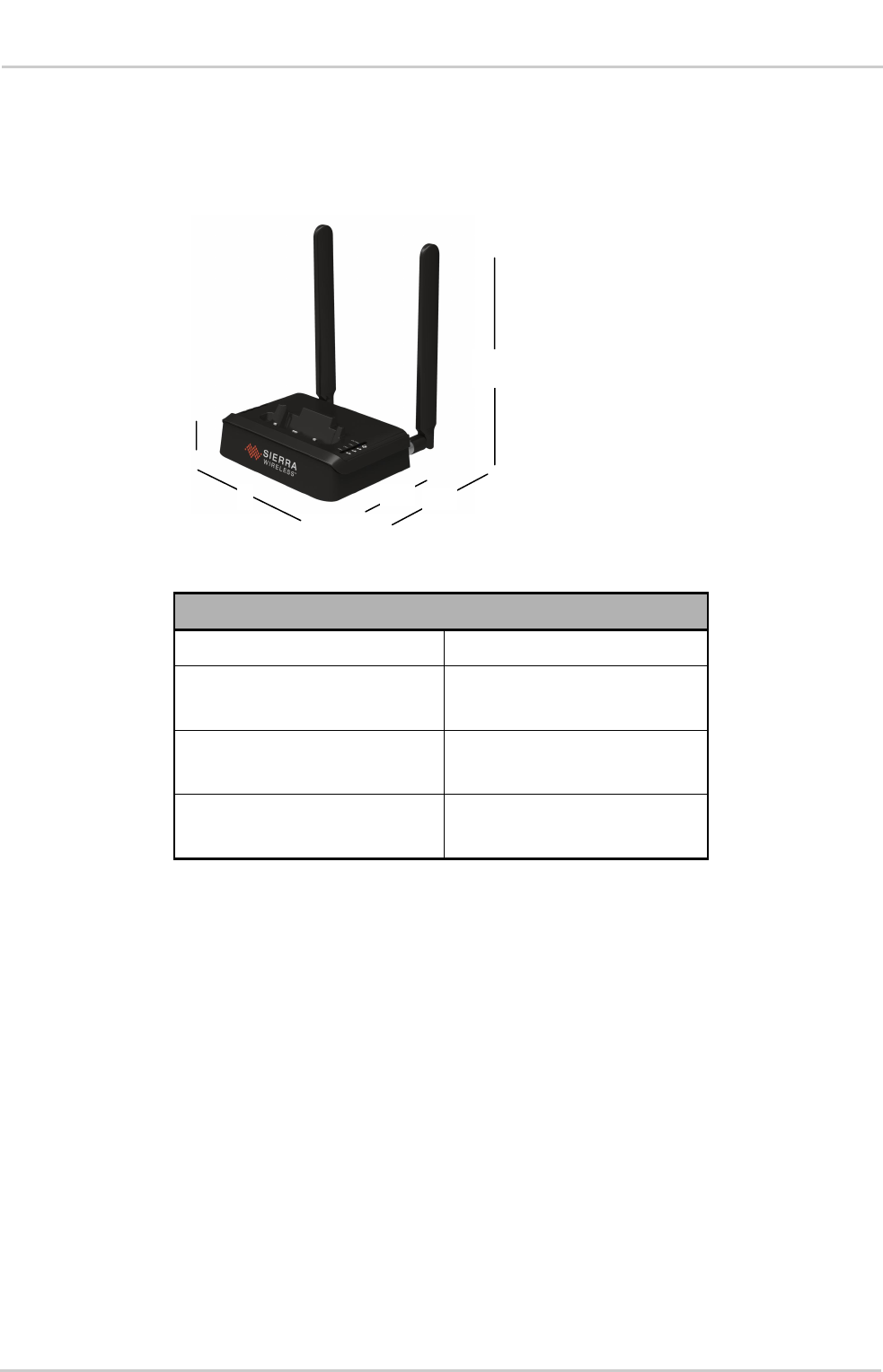
58 2400164
NHD1W User Guide
Mechanical Specifications
NHD1W dimensions
Length (l)
160 mm
Height (h1)
Height (with antennas) (h2)
30 mm
200 mm
Width (w1)
Width (with antennas) (w2)
105 mm
150 mm
Weight
Weight (with antennas)
322 g
416 g
w2
h2
w1
h1
l

Rev 1 Feb. 2012 59
6: FAQ
Does the NHD1W require any configuration out of the box?
No; the NHD1W is a plug-and-play device. Plug the device into an electrical outlet and,
once the WLAN and WWAN indicator lights stop flashing, you can use the device. For Wi-Fi
connectivity, the SSID (Service Set Identifier) and network key (password) are displayed on
the AirCard mobile hotspot’s LCD screen. If you would like to customize your settings you
can enter http://swi.hub into your Web browser to access the NHD1W’s homepage.
The NHD1W was connected but cannot get back online. What should I
do?
You may need to enable the periodic ping timer using the System Monitor feature (see page
50). This ensures that, if the connection drops (that is, outage on the network), that the
NHD1W will reboot after a number of failed pings and then force a re-connect. A timer
setting of around 15 minutes should be sufficient.
Note: The traffic generated by the periodic ping feature is counted as chargeable usage; please keep
this in mind when selecting how often to ping.
What should I do if the NHD1W is rebooting frequently?
Check the Services > System Monitor settings (see page 50) on the NHD1W homepage
and see if the “Force Reset every” timeout is set to a value other than 0. A value of 1, for
example means the unit will reboot every minute regardless of what happens. Reset it to 0 if
you don’t want this feature, or set it to a larger value if you don’t want the NHD1W to reboot
so often.
Can I change the name and password of my wireless network?
Yes, but the NHD1W uses the wireless network credentials from your AirCard mobile
hotspot. You can modify these settings by logging in to your AirCard mobile hotspot’s
homepage.
If you are operating in Power User mode, you can change your NHD1W settings from the
NHD1W’s homepage (http://swi.hub) and switching to advanced view. You can change the
SSID (Service Set Identifier), the security standard (WPA, WPA2, WEP) and your Wi-Fi
password.

60 2400164
NHD1W User Guide
How do I share my Internet connection with other users?
Give the SSID (Service Set Identifier) and Wi-Fi network password for your NHD1W to all
users you want to share your Wi-Fi Internet connection with. Each user will need to select
the NHD1W SSID, on their Wi-Fi enabled computer or device and enter the Wi-Fi network
password you provide. Alternatively, users can use the WPS feature, if their devices
support it. See Quick Wi-Fi Setup on page 20.
I forgot my Management Console password. What can I do?
If you have forgotten your Management Console password and cannot log in as
administrator, reset your NHD1W back to default settings. To reset your device, press and
hold the reset button on the back of your NHD1W for more than 12 seconds, until all the
indicator lights on the unit will flash. After a reset, the NHD1W will boot up into Easy mode.
Note: Resetting the NHD1W using the RESET button will also reset any custom settings and
passwords you may have already set up.

Rev 1 Feb. 2012 61
7: Regulatory Information
Caution: The antennas of NHD1W must be 20 cm or more from users during operation, to
satisfy FCC / IC RF exposure requirements.
Where appropriate, the use of the equipment is subject to the following conditions:
If this equipment does cause harmful interference to radio or television reception,
which can be determined by turning the equipment off and on, the user is encouraged
to try to correct the interference by one or more of the following measures:
Increase the separation between the equipment and receiver
Connect the equipment into an outlet on a circuit different from that to which
the receiver is connected
Consult the dealer or an experienced radio/TV technician for help
United States FCC Information –
This device complies with part 15 of the FCC Rules. Operation is subject to the following two
conditions: (1) This device may not cause harmful interference, and (2) this device must
accept any interference received, including interference that may cause undesired operation.
This device has been tested and found to comply with the limits for a Class B digital device,
pursuant to Part 15 of the FCC Rules. These limits are designed to provide reasonable
protection against harmful interference in a residential installation. This equipment
generates, uses and can radiated radio frequency energy and, if not installed and used in
accordance with the instructions, may cause harmful interference to radio communications.
However, there is no guarantee that interference will not occur in a particular installation If
this equipment does cause harmful interference to radio or television reception, which can be
determined by turning the equipment off and on, the user is encouraged to try to correct the
interference by one or more of the following measures:
-Reorient or relocate the receiving antenna.
-Increase the separation between the equipment and receiver.
-Connect the equipment into an outlet on a circuit different from that to which the receiver is
connected.
-Consult the dealer or an experienced radio/TV technician for help.
Changes or modifications not expressly approved by the party responsible for compliance
could void the user‘s authority to operate the equipment.
If you have purchased this product under a United States Government contract, it
shall be subject to restrictions as set forth in subparagraph (c)(1)(ii) of Defense
Federal Acquisitions Regulations (DFARs) Section 252.227-7013 for Department of
Defense contracts, and as set forth in Federal Acquisitions Regulations (FARs)
Section 52.227-19 for civilian agency contracts or any successor regulations. If
further government regulations apply, it is your responsibility to ensure compliance
with such regulations.
This device is only authorized to use with AirCard, FCC ID: N7NAC763S.
Antenna Information is as shown below:
Antenna Type: External Antenna
Antenna Gain: 850 band: 1.00 dBi; 1900 band: 1.75 dBi; LTE Band 4: 1.75dBi; LTE Band 7: 3.00dBi

62 2400164
NHD1W User Guide
This device complies with Industry Canada licence-exempt RSS standard(s).
Operation is subject to the following two conditions:
(1) this device may not cause interference, and
(2) this device must accept any interference, including interference that may
cause undesired operation of the device.
IC Regulations:
This Class B digital apparatus complies with Canadian ICES-003.
Cet appareil numérique de la classe B est conforme à la norme NMB-003 du Canada.
Le présent appareil est conforme aux CNR d'Industrie Canada applicables aux
appareils radio exempts de licence. L'exploitation est autorisée aux deux conditions
suivantes :
(1) l'appareil ne doit pas produire de brouillage, et
(2) l'utilisateur de l'appareil doit accepter tout brouillage radioélectrique subi,
même si le brouillage est susceptible d'en compromettre le fonctionnement.
Regulatory Information for EU countries
To ensure safe use, the NHD1W must be 20 cm or more from users during operation.
NetComm Wireless hereby declares that the NetComm Wireless NHD1W conforms
to all the essential requirements of Directive 1999/5/EC:
The Declaration of Conformity made under Directive 1999/5/EC is available for
viewing at the following location in the EU community:
Suite 5, the Hub
Fowler Avenue
Farnborough Business Park
Farnborough, United Kingdom GU14 7JP
Notice: User restrictions for Wi-Fi operation apply in France. Please check with French
authorities before using this device in France.

Regulatory Information
Rev 1 Feb. 2012 63
Regulatory Information for Australia
To ensure safe use, the modem must be 20 cm or more from users during operation.
The Australian Communications & Media Authority (ACMA) requires you to be aware
of the following information and warnings:
1. This unit may be connected to the Telecommunication Network through a line
cord which meets the requirements of the AS/CA S008-2011 Standard.
2. This equipment has been tested and found to comply with the Standards for C-
Tick as set by the ACMA. These standards are designed to provide reasonable
protection against harmful interference in a residential installation. This
equipment generates, uses, and can radiate radio noise and, if not installed and
used in accordance with the instructions detailed within this manual, may cause
interference to radio communications. However, there is no guarantee that
interference will not occur with the installation of this product in your home or
office. If this equipment does cause some degree of interference to radio or
television reception, which can be determined by turning the equipment off and
on, we encourage the user to try to correct the interference by one or more of
the following measures:
Change the direction or relocate the receiving antenna.
Increase the separation between this equipment and the receiver.
Connect the equipment to an alternate power outlet on a different power
circuit from that to which the receiver/TV is connected.
Consult an experienced radio/TV technician for help.
3. The power supply that is provided with this unit is only intended for use with this
product. Do not use this power supply with any other product or do not use any
other power supply that is not approved for use with this product by NetComm
Wireless. Failure to do so may cause damage to this product, fire or result in
personal injury.
WWAN FCC ID: N7NAC763S is authorized for use with this product.
Antenna information as below:
Antenna type: External Antenna
Antenna gain:
850 Band : 1.00 dBi
1900 Band : 1.75 dBi
